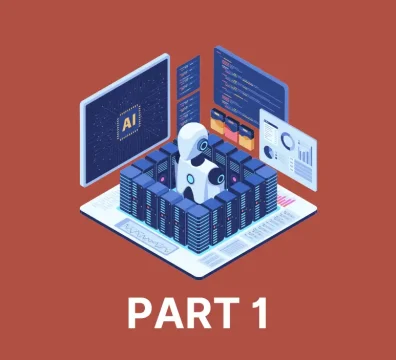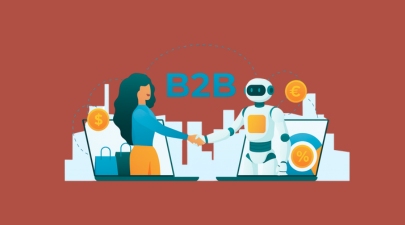This section explores the operational backbone of modern eCommerce—where AI ensures scalability, efficiency, and trust. Beyond the visible shopping experience, AI systems work quietly in the background to set optimal prices, forecast demand, streamline inventory, automate warehouses, detect fraud, and even reduce environmental impact. These functions may be less visible to customers, but they are critical to ensuring smooth, cost-effective, and trustworthy operations.
The importance of these applications lies in their ability to balance growth with stability. By predicting shifts in supply and demand, reducing waste, securing billions of transactions, and supporting sustainable practices, AI helps businesses remain resilient in fast-changing markets. While Part 1 focused on customer-facing engagement—personalization, chatbots, semantic search—Part 2 proves that these experiences only succeed when operations are intelligent and resilient. In other words, the hidden infrastructure is what powers the visible delight, turning ambitious customer experiences into everyday realities.
Table of Contents
AI in Pricing & Inventory
Pricing and inventory management are two of the most challenging aspects of running an eCommerce business. Unlike brick-and-mortar retail, online commerce is highly dynamic: customer demand changes rapidly, competitors adjust prices in real time, and global supply chains create new risks around availability. Traditional approaches to pricing and inventory, which rely heavily on manual adjustments or historical averages, are no longer sufficient. Among the most transformative AI in eCommerce examples are those that apply artificial intelligence to optimize pricing strategies and manage inventory in real time.

AI-powered pricing engines and inventory management systems use advanced algorithms to analyze vast datasets that include demand signals, competitor activity, seasonal patterns, and even external factors like weather or economic conditions. These systems make predictions and recommendations that allow retailers to react quickly to market changes, reduce losses, and maximize profitability. These AI in eCommerce examples highlight how artificial intelligence is turning pricing and inventory from reactive processes into proactive, data-driven strategies.
Dynamic pricing engines
One of the most influential AI in eCommerce examples is the application of dynamic pricing engines, systems that automatically adjust product prices in real time based on a wide variety of internal and external signals. Unlike static pricing models, which rely on fixed prices or infrequent manual changes, dynamic pricing leverages machine learning and predictive analytics to optimize prices continuously. This technology allows eCommerce businesses to remain competitive, maximize profits, and respond instantly to changes in demand, supply, and competitor behavior.

Dynamic pricing has long been used in industries like aviation and hospitality, where flight tickets and hotel rooms are repriced multiple times a day. Today, it has become one of the most important AI in eCommerce examples, directly shaping how online retailers manage promotions, handle competition, and meet consumer expectations. With margins under pressure and consumers highly sensitive to price fluctuations, dynamic pricing provides a critical competitive edge in fast-changing markets.
Amazon’s repricing millions of SKUs per day
Perhaps the most cited AI in eCommerce examples of dynamic pricing comes from Amazon. The retail giant manages an enormous catalog with hundreds of millions of SKUs across countless categories, ranging from books and electronics to household essentials and fashion. To remain competitive in every category, Amazon uses advanced AI-driven repricing systems that automatically update prices for millions of products multiple times per day.
These systems monitor competitor websites, third-party seller prices, supply levels, and customer behavior patterns in real time. If a competitor drops the price of a popular item, Amazon’s AI system can immediately match or beat that price to maintain its dominance. Similarly, if demand for a product surges due to seasonal trends, viral popularity, or social media influence, Amazon can adjust prices upward to maximize margins while still meeting customer expectations.
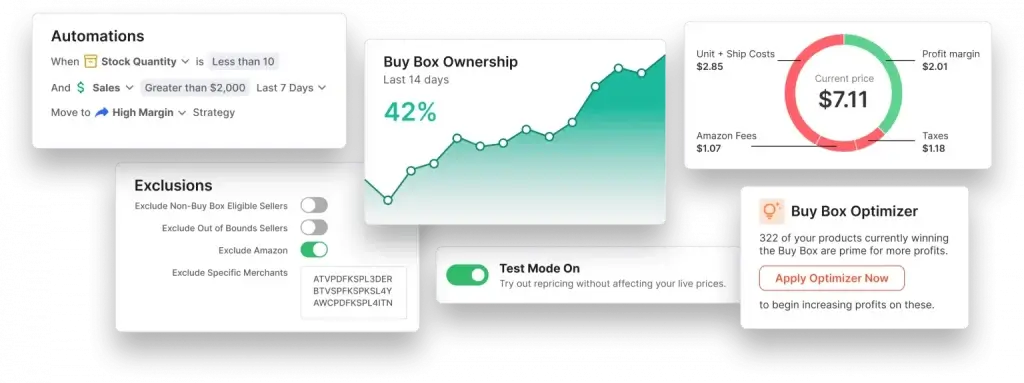
These AI in eCommerce examples highlight not only the efficiency of AI-driven pricing but also its scale. No human pricing team could ever reprice millions of items daily while analyzing competitor actions across global markets. Amazon’s system proves how AI enables retailers to maintain control over vast and diverse inventories without sacrificing competitiveness. For consumers, this creates a perception that Amazon consistently offers fair, up-to-date pricing. For the business, it ensures profitability and efficient turnover, even in categories with razor-thin margins.
The result is a self-reinforcing cycle: optimized pricing attracts more customers, which generates more data, which in turn makes AI models more accurate. This virtuous cycle is one of the clearest AI in eCommerce examples of how scale and intelligence combine to create a near-insurmountable competitive advantage.
Uber surge pricing adapted to eCommerce promotions
Another fascinating angle among AI in eCommerce examples of dynamic pricing is the adaptation of surge pricing models originally developed by ride-hailing companies like Uber. Surge pricing uses AI to adjust fares dynamically based on supply and demand. During peak times, such as rush hour or bad weather, fares increase to balance rider demand with driver availability. This concept has since been adapted for eCommerce, particularly during high-demand promotional periods such as flash sales, Black Friday, or seasonal campaigns.
In eCommerce, the equivalent of surge pricing involves adjusting promotional offers or discounts in real time to manage demand, maximize sales, and protect inventory. For example, if a retailer launches a limited-time sale on popular electronics, AI systems can monitor traffic spikes, cart activity, and checkout completion rates. If demand far exceeds expectations, the system might reduce discounts slightly to preserve margins or slow the rate of stock depletion. Conversely, if a promotion underperforms, AI can increase discounts or highlight the offer more prominently to boost sales.
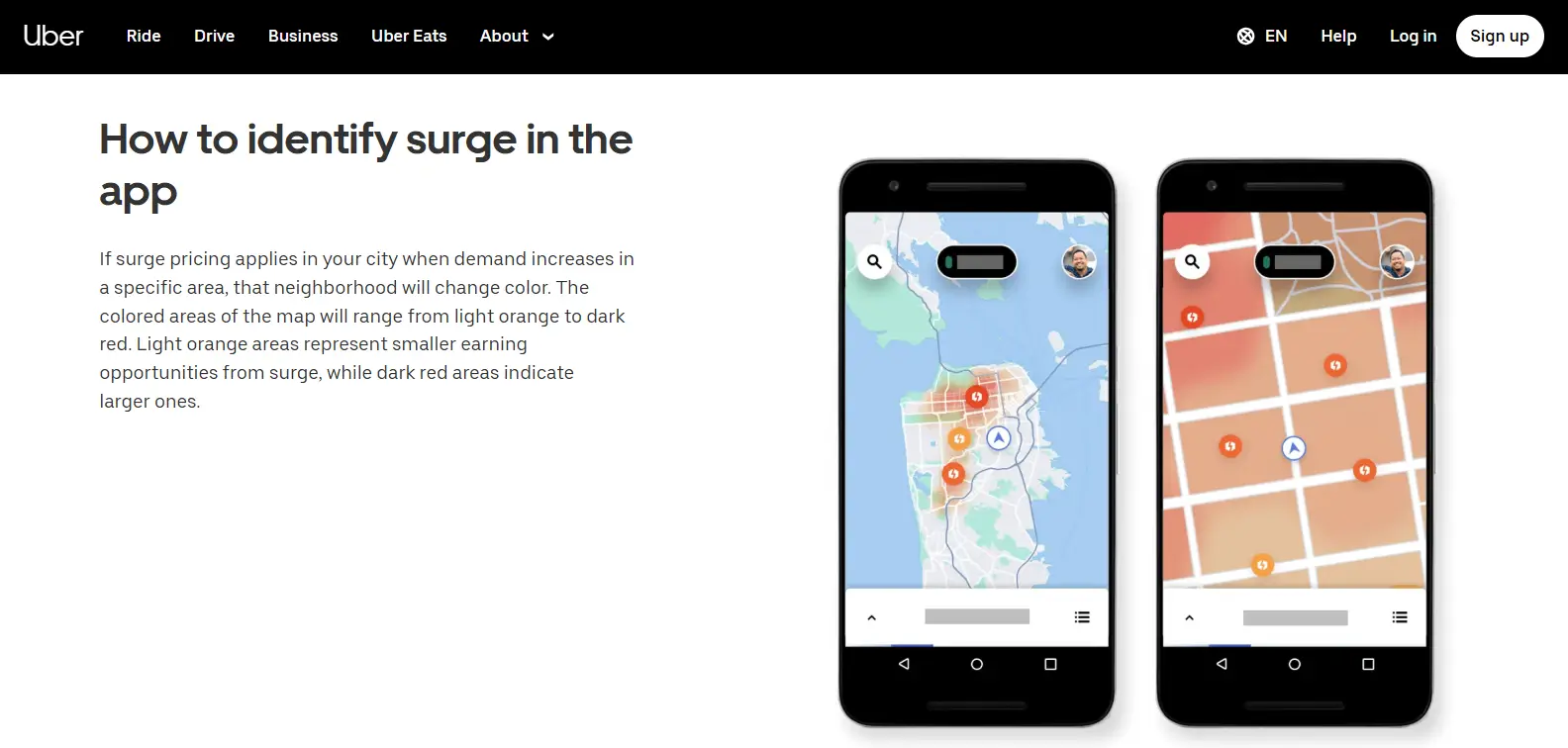
These AI in eCommerce examples illustrate how surge-inspired dynamic pricing prevents retailers from leaving money on the table while also avoiding customer frustration from stockouts. By reacting instantly to demand surges, AI ensures that promotions remain profitable and balanced. For businesses running large-scale campaigns with thousands of SKUs, this adaptability is essential. It reduces waste, optimizes campaign performance, and creates a smoother customer experience where expectations align with availability.
The Uber analogy underscores an important point: AI in eCommerce examples often involve cross-industry adaptation. Technologies pioneered in one sector, such as transportation, are now being repurposed to solve eCommerce challenges. Dynamic pricing engines exemplify this transfer of innovation, proving that AI’s versatility enables breakthroughs across industries.
Result: Competitive edge in fast-changing markets
The most significant outcome of these AI in eCommerce examples is the competitive edge dynamic pricing offered in markets where change is constant. In today’s digital landscape, consumers can compare prices across multiple platforms within seconds. This transparency creates a race to deliver not only the best prices but also the most consistent and fair offers. Retailers relying on static pricing models risk losing customers to competitors who can adjust prices more quickly.
Dynamic pricing engines powered by AI provide the agility retailers need. These systems can analyze competitor prices, currency fluctuations, macroeconomic trends, and even social sentiment in real time. For instance, if a competitor launches an aggressive discount campaign, AI can instantly adjust prices to remain competitive without manual intervention. If shipping delays threaten supply, the system can increase prices subtly to extend inventory life and reduce demand pressure. These AI in eCommerce examples show how businesses can remain resilient and profitable even in volatile markets.

The competitive advantage extends beyond pricing itself. By using AI to optimize prices, retailers also gain valuable insights into customer behavior. For example, dynamic pricing systems can reveal which customers are highly price-sensitive versus those more influenced by convenience or brand loyalty. These insights feed into broader marketing and merchandising strategies, shaping everything from promotional planning to product assortment.
In fast-changing markets, time is everything. Manual repricing simply cannot keep up with the speed of consumer expectations and competitive dynamics. These AI in eCommerce examples demonstrate that dynamic pricing engines are not just tools for profitability—they are survival mechanisms in industries where agility defines success.
Inventory forecasting
Inventory forecasting is one of the most complex yet essential aspects of managing an eCommerce business. Retailers must walk a fine line: too much inventory leads to excess storage costs, markdowns, and waste, while too little inventory results in stockouts, missed sales opportunities, and dissatisfied customers. Traditional forecasting methods relied heavily on historical data and manual judgment, which often failed to account for sudden shifts in consumer behavior, seasonality, or external shocks. Among the most impactful AI in eCommerce examples are those where artificial intelligence is applied to inventory forecasting, enabling retailers to predict demand with greater accuracy and adapt their supply chains in real time.

AI-driven forecasting engines use machine learning algorithms to analyze vast datasets, including sales history, customer browsing behavior, competitor activity, weather forecasts, local events, and even social media trends. By processing these variables, AI generates precise predictions of product demand across regions, channels, and time periods. These AI in eCommerce examples demonstrate how artificial intelligence can reduce uncertainty in supply chain planning, ensuring that the right products are available in the right place at the right time. The result is fewer lost sales, lower carrying costs, and a more efficient allocation of resources.
Zara using AI for demand prediction in fast fashion
One of the most prominent AI in eCommerce examples of inventory forecasting comes from Zara, the global fast fashion brand. Zara operates in one of the most volatile retail sectors, where customer preferences change rapidly and product life cycles are short. In fast fashion, being too early or too late with stock can make or break profitability. To address this, Zara has integrated AI into its demand prediction systems to anticipate customer needs more accurately.
Zara’s AI analyzes sales data from stores worldwide, online browsing behavior, and even feedback from store managers who report real-time customer trends. The system detects patterns—such as a sudden spike in interest for a specific style of dress—and predicts how demand will evolve across markets. These AI in eCommerce examples illustrate how Zara can react almost instantly, adjusting production and distribution to ensure that high-demand items are delivered quickly to stores and warehouses.

The benefits are clear: fewer stockouts, faster response to trends, and minimized waste. In the fast fashion industry, where overproduction can lead to massive markdowns and unsold inventory, AI helps Zara strike the perfect balance. These AI in eCommerce examples prove that artificial intelligence does not just improve efficiency; it enables an entirely new operating model where agility and precision are competitive advantages. By leveraging AI, Zara has redefined how fast fashion can adapt to consumer demand while maintaining profitability and sustainability.
Walmart’s predictive supply chain platform
Another strong case among AI in eCommerce examples is Walmart’s predictive supply chain platform. As one of the world’s largest retailers, Walmart faces a monumental challenge in managing inventory across thousands of stores and a massive eCommerce operation. To stay ahead, Walmart has invested heavily in AI systems that forecast demand and optimize supply chain operations.
Walmart’s platform integrates data from numerous sources: historical sales, local weather patterns, holidays, promotions, and even community-level events. Machine learning algorithms analyze these factors to predict demand at a granular level—sometimes down to individual stores. These AI in eCommerce examples highlight how Walmart can anticipate surges in demand for essentials like bottled water before a storm or increased sales of outdoor gear during warm weather.

By combining predictive analytics with real-time supply chain adjustments, Walmart ensures that products are stocked where they are needed most. This reduces lost sales from empty shelves and avoids unnecessary storage costs from overstocking in the wrong locations. These AI in eCommerce examples show how predictive supply chain platforms create resilience and efficiency, enabling retailers to respond to both everyday fluctuations and extraordinary disruptions like global supply chain crises.
The results are tangible: Walmart consistently achieves fewer stockouts, improved customer satisfaction, and optimized storage across its vast network. These AI in eCommerce examples demonstrate that predictive inventory systems are not just operational tools—they are strategic enablers that allow retail giants to compete effectively in an unpredictable world.
Result: Fewer lost sales and optimized storage
The ultimate value of these AI in eCommerce examples lies in their ability to minimize lost sales and optimize storage. Stockouts have long been one of the biggest pain points in eCommerce. A customer who cannot find the product they want is likely to leave and purchase from a competitor. AI-driven forecasting reduces the risk of this scenario by predicting demand more accurately and ensuring stock availability. Retailers can proactively allocate inventory to the locations and channels where it is most likely to sell, keeping customers satisfied and loyal.

Optimized storage is another critical advantage. Overstocking not only ties up capital but also incurs significant warehousing costs, particularly in industries with low margins. Traditional forecasting often erred on the side of caution, leading businesses to keep excess safety stock “just in case.” These AI in eCommerce examples show how predictive analytics enables leaner, more efficient storage strategies without sacrificing service levels. By forecasting demand with high accuracy, retailers can lower carrying costs, reduce waste, and improve profitability.
The sustainability implications are equally important. Excess inventory often ends up heavily discounted, destroyed, or discarded, contributing to environmental waste. By ensuring that products are produced and stocked in alignment with real demand, AI-driven forecasting supports more sustainable retail practices. These AI in eCommerce examples prove that optimizing inventory is not just a financial advantage but also a contribution to environmental responsibility.
Reducing stockouts & overstocks
AI systems take into account not only historical sales data but also real-time demand signals, competitor actions, weather events, social media trends, and promotional calendars. By continuously analyzing these variables, AI can predict where stockouts are most likely to occur and where overstocks pose a risk, allowing businesses to act proactively. These AI in eCommerce examples show how advanced algorithms deliver measurable improvements in customer satisfaction and cost efficiency by ensuring inventory is in the right place at the right time.
Ocado AI-powered warehouse decisions
One of the most advanced AI in eCommerce examples of reducing stockouts and overstocks comes from Ocado, the UK-based online-only supermarket and logistics technology company. Ocado is widely recognized for its cutting-edge automated warehouses, where AI plays a central role in orchestrating inventory flows. The company operates highly complex fulfillment centers, with thousands of robots moving across grids to pick and pack orders. Behind the scenes, AI algorithms analyze sales data, customer orders, and inventory levels to make real-time decisions about what products to stock, how much of each to reorder, and where to allocate resources.
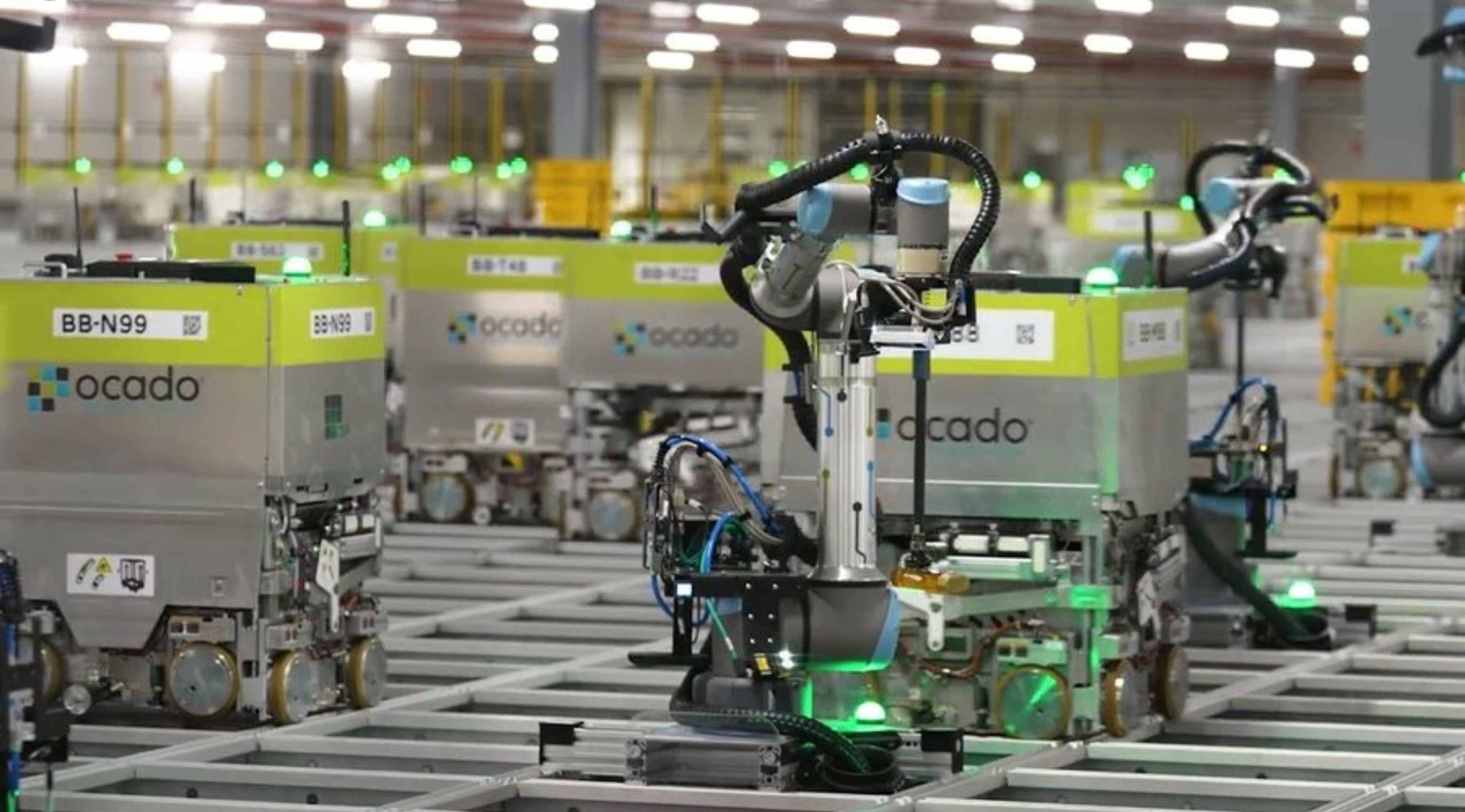
Ocado’s AI-driven systems can anticipate demand spikes based on factors such as holidays, regional preferences, and weather forecasts. For example, if a heatwave is predicted, the AI system increases orders of bottled water, ice cream, and barbecue supplies. This proactive approach reduces the risk of stockouts during peak demand. At the same time, Ocado avoids overstocks by continuously monitoring sell-through rates and adjusting purchasing decisions accordingly. These AI in eCommerce examples demonstrate how machine learning enables hyper-efficient inventory allocation, ensuring both availability for customers and profitability for the retailer.
The benefits are substantial. Ocado achieves higher order accuracy, fewer substitutions, and reduced waste compared to traditional supermarkets. Customers experience fewer stockouts, receiving the items they expect with minimal disruption. Meanwhile, the company reduces excess inventory and associated costs. These AI in eCommerce examples highlight how intelligent warehouse management creates a seamless experience for both businesses and consumers, redefining what efficiency means in digital retail.
Target balancing seasonal inventory
Another powerful illustration among AI in eCommerce examples comes from Target, one of the largest retailers in the United States. Seasonal inventory management has always been a major challenge in retail. Products like holiday decorations, back-to-school supplies, or summer apparel experience sharp peaks in demand followed by rapid declines. Overstocking these items can lead to massive markdowns after the season ends, while stockouts during peak periods mean lost opportunities and disappointed customers.
Target uses AI to balance seasonal inventory more effectively. By analyzing historical sales data, local market trends, and promotional schedules, AI systems forecast demand with high precision. For example, the system can predict how many Christmas lights will sell in specific regions based on weather patterns, income levels, and previous seasonal trends. AI also incorporates real-time sales data to adjust forecasts during the season itself, ensuring that inventory decisions remain responsive.

These AI in eCommerce examples show how Target uses predictive analytics to ensure shelves are stocked when customers need products most, without overcommitting to excess supply. By striking this balance, Target minimizes markdowns, reduces waste, and preserves margins while maximizing customer satisfaction. Seasonal inventory, once one of the riskiest aspects of retail, becomes manageable and predictable with AI.
The results extend beyond profitability. Customers consistently find the seasonal products they expect, strengthening loyalty and trust in the brand. These AI in eCommerce examples emphasize how balancing stock levels during critical sales periods is not only a financial advantage but also a driver of customer experience and long-term retention.
Result: Improved customer satisfaction and cost savings
The overarching impact of these AI in eCommerce examples is clear: reducing stockouts and overstocks leads to happier customers and healthier bottom lines. When shoppers find the products they want in stock, they are more likely to complete their purchases, return for future orders, and recommend the retailer to others. Fewer stockouts directly translate into fewer lost sales and stronger brand loyalty.
At the same time, minimizing overstocks reduces financial waste. Excess inventory ties up working capital, clogs storage facilities, and often requires costly clearance sales. By using AI to forecast demand accurately and adjust stock levels dynamically, retailers can operate leaner supply chains that are more cost-effective and sustainable. These AI in eCommerce examples demonstrate how artificial intelligence addresses two of the most persistent inefficiencies in retail simultaneously, delivering both operational savings and improved customer experience.

Another important dimension is sustainability. Overstocking often results in products being discarded when they cannot be sold, contributing to environmental waste. AI reduces this by aligning supply more closely with demand. These AI in eCommerce examples prove that smarter inventory management is not only a business imperative but also an environmental one, supporting broader corporate sustainability goals.
The strategic implications are equally significant. By reducing stockouts and overstocks, businesses can reallocate resources previously spent on damage control—such as emergency replenishments, markdown campaigns, or excess warehousing—toward growth initiatives like product development, marketing, or customer engagement. These AI in eCommerce examples highlight how efficiency in inventory management unlocks opportunities across the entire organization.
AI in Logistics & Fulfillment
While marketing, pricing, and customer experience often receive the most attention in digital commerce, logistics and fulfillment are the silent engines that determine whether customers ultimately remain satisfied. Shoppers may be enticed by clever ads and optimized pricing, but their loyalty is cemented by how quickly and accurately orders arrive at their doorsteps. Among the most transformative AI in eCommerce examples are those applied to logistics and fulfillment, where artificial intelligence ensures that goods move from warehouses to customers with unprecedented speed, accuracy, and efficiency.
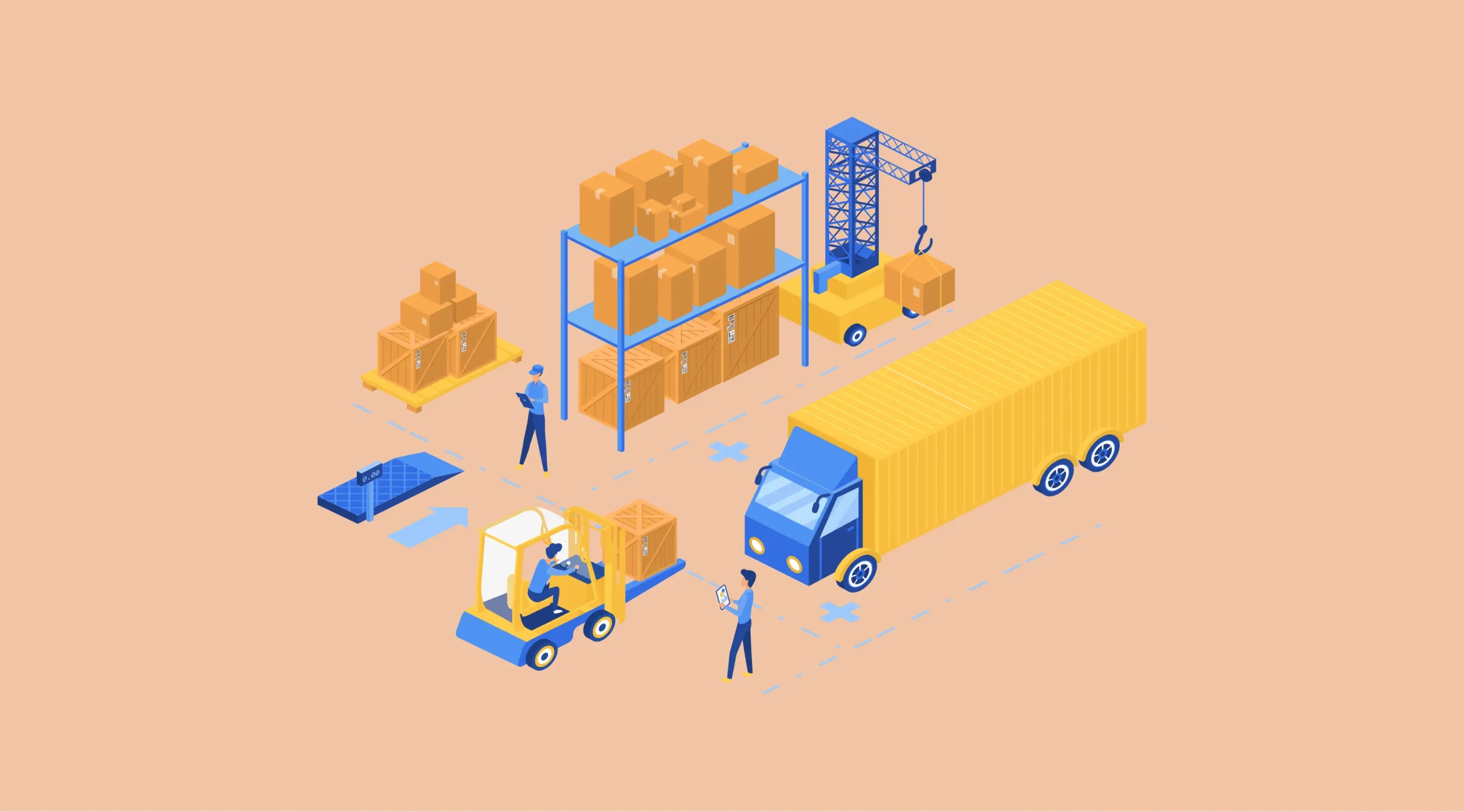
Traditional logistics relied heavily on manual planning, static routing, and reactive adjustments to supply chain disruptions. In today’s fast-paced, globalized environment, those methods fall short. Artificial intelligence changes the equation by analyzing massive amounts of data in real time—orders, traffic conditions, weather reports, warehouse stock levels, and even geopolitical risks—to streamline operations end to end. These AI in eCommerce examples demonstrate how AI optimizes warehouse management, last-mile delivery, and supply chain coordination, creating a seamless backbone for the customer experience.
Warehouse automation
Warehouse automation has become one of the most striking AI in eCommerce examples, showing how artificial intelligence can reshape the backbone of fulfillment operations. In a digital economy where customers expect next-day or even same-day delivery, the speed and efficiency of warehouse processes are critical. Traditional warehouses often relied on large human workforces performing repetitive tasks such as picking, packing, and sorting. While functional, this model introduced inefficiencies: human error, slow order turnaround times, and escalating labor costs during peak seasons. AI-driven warehouse automation changes this equation by integrating robotics, computer vision, and predictive algorithms into every stage of fulfillment.
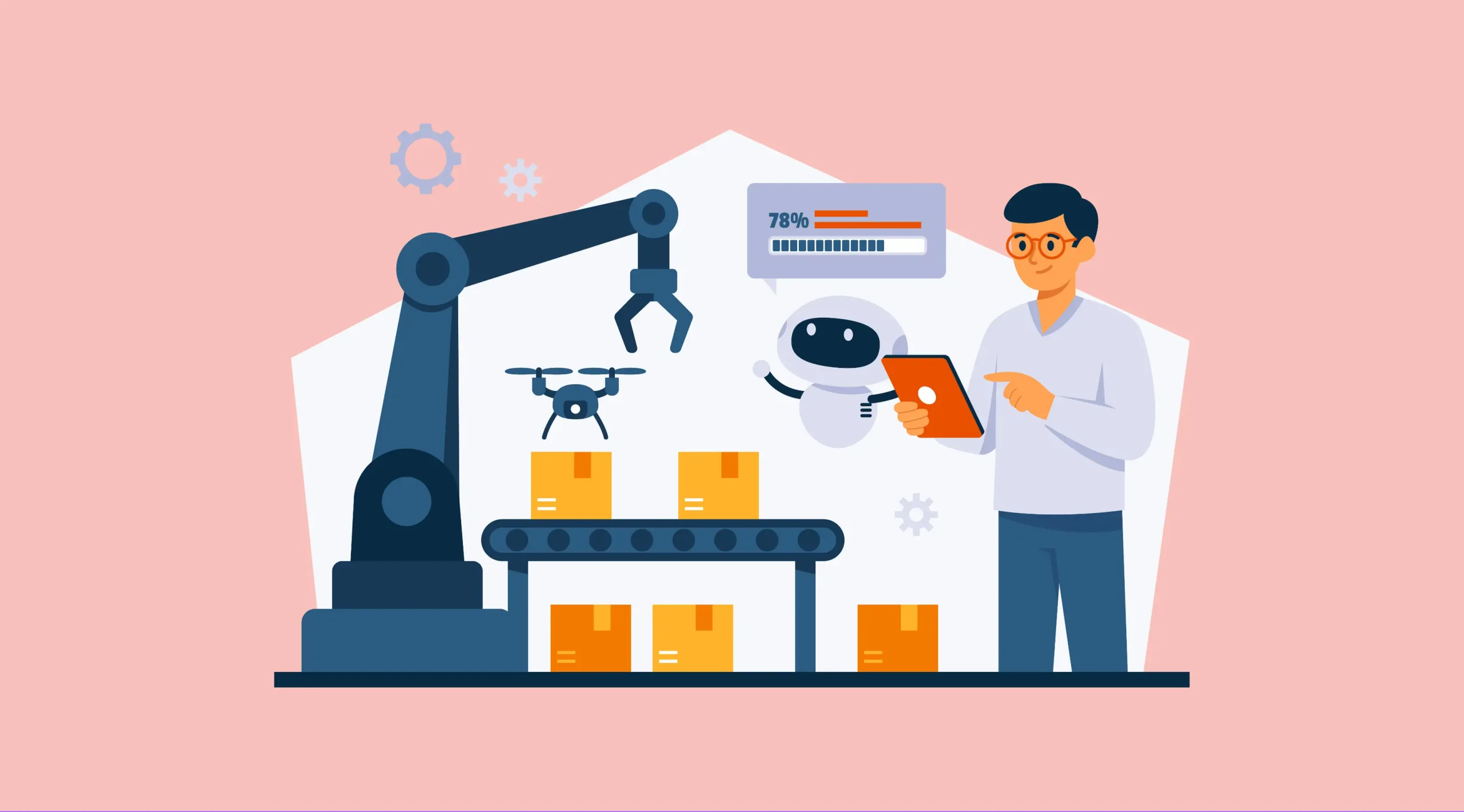
These AI in eCommerce examples demonstrate how warehouses are no longer simply storage facilities but highly intelligent ecosystems designed for scalability and precision. By combining robotics with data-driven insights, retailers can handle surging order volumes without proportionally increasing labor, reduce picking and packing errors, and adapt quickly to market fluctuations. Companies like Ocado and Amazon are global leaders in this transformation, offering vivid case studies of how warehouse automation powered by AI delivers both operational efficiency and scalability.
Ocado Smart Platform robots
One of the most advanced AI in eCommerce examples in warehouse automation comes from Ocado, the UK-based online supermarket known for its sophisticated logistics technology. Ocado developed the Ocado Smart Platform (OSP), a highly automated system that integrates AI with robotics to manage thousands of customer orders daily.
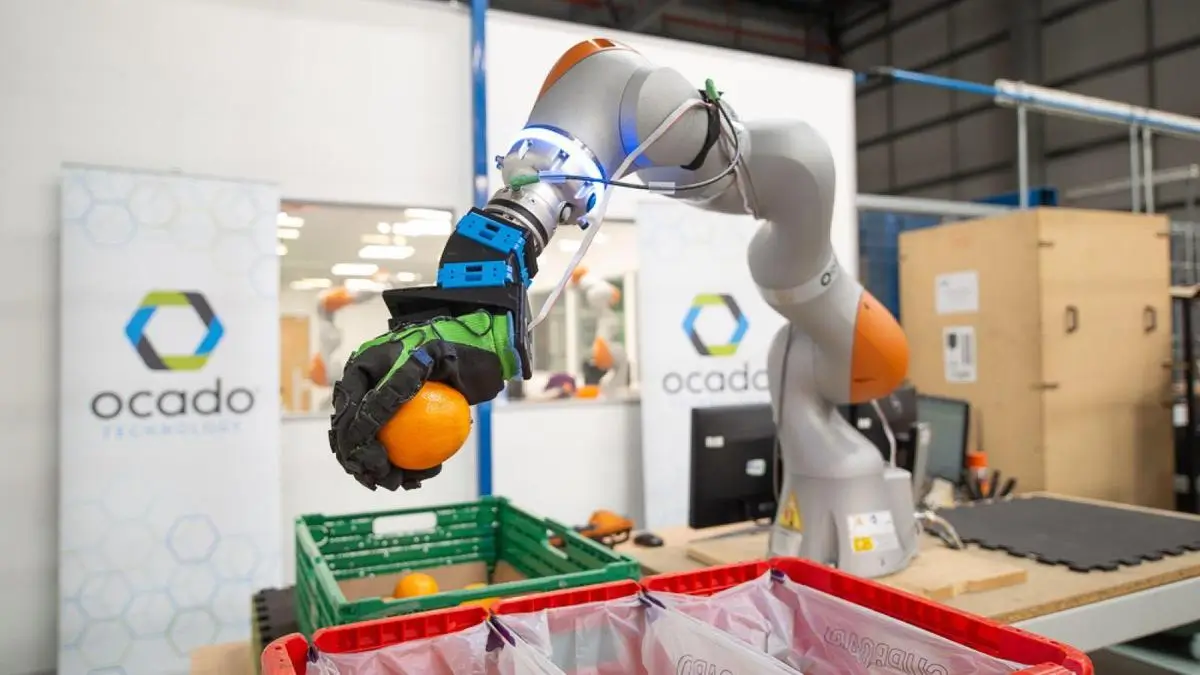
The OSP operates through fleets of cube-shaped robots that move across a giant grid system above stacks of storage bins. Each robot is guided by AI algorithms that determine the fastest routes to retrieve items, coordinate with other robots to avoid collisions, and ensure products are picked in the optimal sequence for packing. These AI in eCommerce examples highlight how intelligence is layered onto robotics, transforming a potentially chaotic process into a synchronized dance of thousands of machines working in harmony.
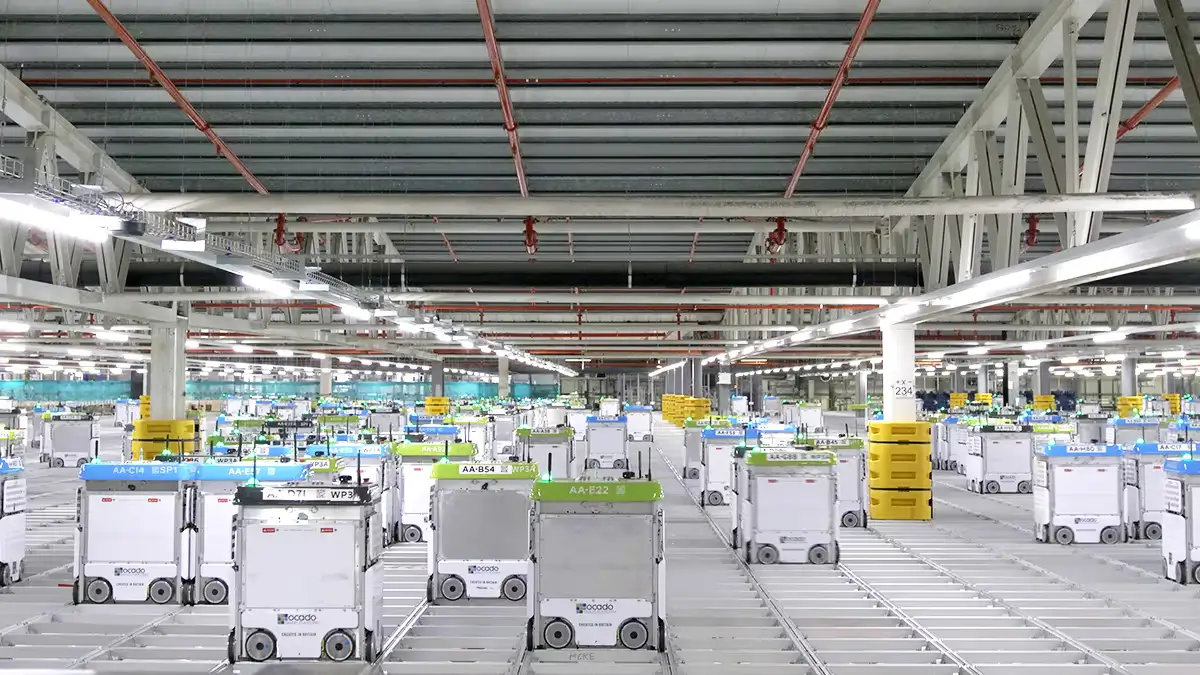
The AI system goes beyond mere navigation. It also predicts which items will be in demand and positions them strategically in the grid for quicker access. For instance, if seasonal data shows that soft drinks and barbecue items spike during summer weekends, these products are placed closer to the grid surface. This predictive placement reduces retrieval times, accelerates order processing, and minimizes the risk of stockouts.
The result is an operation that outpaces traditional warehouses by a wide margin. Orders that might have taken hours to process manually can now be completed in minutes. These AI in eCommerce examples from Ocado demonstrate how predictive intelligence and robotics combine to deliver scalability, cost efficiency, and reliability, making the company’s platform attractive not only to its grocery customers but also to global retail partners who license the technology.
Amazon Robotics driving fulfillment speed
Another prominent AI in eCommerce example of warehouse automation is Amazon Robotics, a key driver of the company’s legendary fulfillment speed. Since acquiring Kiva Systems in 2012, Amazon has deployed tens of thousands of robots across its fulfillment centers worldwide. These robots, guided by AI, carry shelves of products directly to human associates who handle final picking and packing. This reduces the need for employees to walk long distances, slashing picking times and boosting efficiency.
The AI at the heart of Amazon Robotics optimizes every aspect of movement and placement within the warehouse. Algorithms determine which products should be stored where, how to minimize travel distances for robots, and how to prioritize orders based on delivery deadlines. These AI in eCommerce examples show how automation doesn’t just replace human labor—it amplifies it. Human workers are freed from repetitive, physically demanding tasks and instead focus on quality control and complex problem solving.
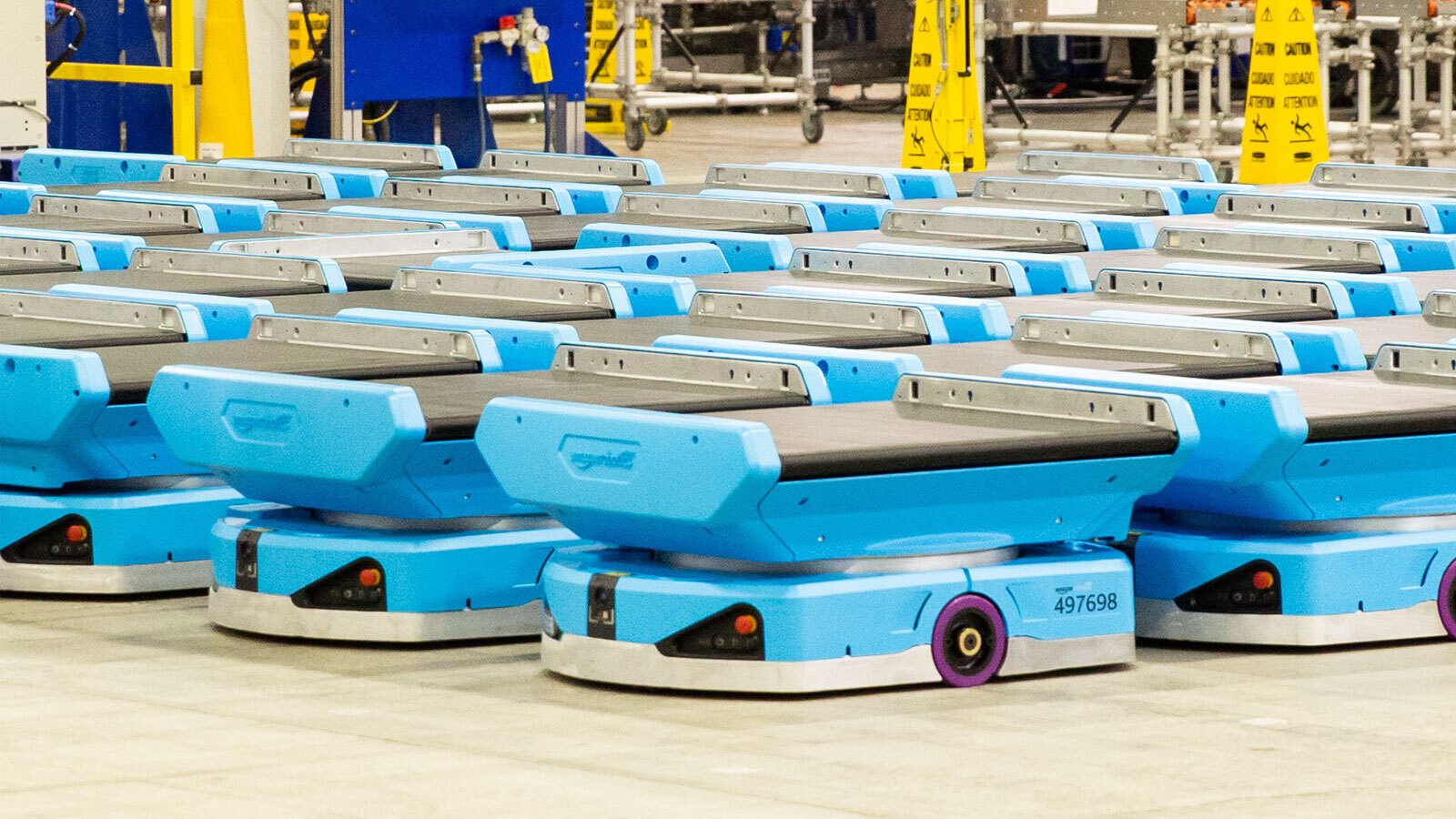
Amazon’s AI systems also handle real-time adjustments. If one robot malfunctions, the AI instantly reroutes others to prevent disruptions. During peak shopping events like Prime Day or the holiday season, AI ensures fulfillment centers can process millions of orders daily without collapsing under pressure. These AI in eCommerce examples highlight how automation and intelligence enable Amazon to maintain its promise of rapid, reliable delivery—a cornerstone of its brand identity.
The scale of Amazon’s robotics program underscores its transformative impact. From a handful of robots a decade ago to over half a million today, the company has built the largest automated fulfillment network in the world. This massive investment illustrates the competitive necessity of AI in eCommerce examples of warehouse automation, where speed and reliability directly translate into customer loyalty.
Result: Scalability and operational efficiency
The most significant outcome of these AI in eCommerce examples is the scalability and operational efficiency they create. Traditional warehouse operations expand linearly—serving more orders requires more space and more workers. With AI-driven automation, scalability becomes exponential. Robots and algorithms can handle surging order volumes with minimal additional resources, making growth far more cost-effective.
Ocado and Amazon both illustrate this scalability. Ocado’s Smart Platform can be replicated in different markets, enabling grocery chains to modernize fulfillment quickly. Amazon’s robotics allow the company to expand into new product categories and regions without a corresponding explosion in costs. These AI in eCommerce examples demonstrate how automation ensures that growth in eCommerce is sustainable rather than overwhelming.
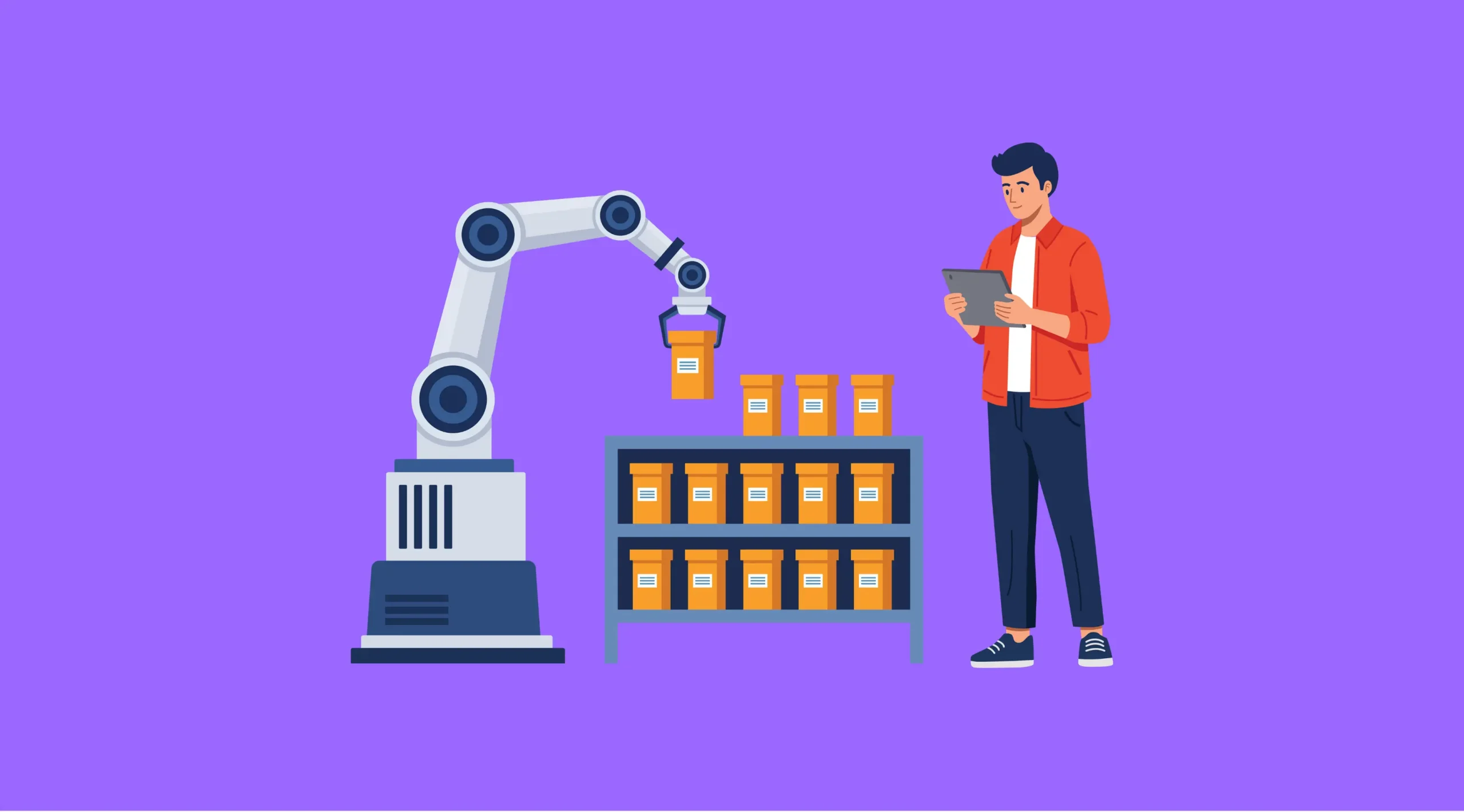
Operational efficiency is another critical benefit. AI reduces picking errors, lowers labor costs, optimizes energy usage, and ensures faster order turnaround. For customers, this translates into reliable delivery and fewer incorrect or delayed shipments. For businesses, it means higher profitability and the ability to reinvest savings into innovation and customer experience. These AI in eCommerce examples show that efficiency gains are not just incremental—they are transformational, redefining the economics of fulfillment.
Moreover, the lessons from warehouse automation extend beyond retail. These AI in eCommerce examples are influencing logistics across industries, from pharmaceuticals to manufacturing. By demonstrating the potential of AI-driven robotics, companies like Ocado and Amazon are setting new global standards for how goods are stored, retrieved, and delivered.
Route optimization & last-mile delivery
Among the most important AI in eCommerce examples are those applied to route optimization and last-mile delivery—the final and often most expensive stage of the supply chain. This stage determines whether customers receive their orders quickly and reliably, and it directly impacts satisfaction, brand loyalty, and repeat purchases. Last-mile delivery is notoriously complex because it involves numerous unpredictable variables: traffic congestion, weather conditions, failed delivery attempts, and fluctuating order volumes. Traditional route planning methods, which relied on static maps and manual scheduling, cannot keep up with these dynamic realities. Artificial intelligence has emerged as the solution, transforming delivery networks into agile, data-driven systems.

AI-driven route optimization works by analyzing massive streams of data in real time. Algorithms account for traffic patterns, delivery density, driver schedules, vehicle capacities, and customer preferences to generate the most efficient delivery routes. These systems continuously update routes as conditions change, ensuring drivers can avoid delays and complete more stops per shift. These AI in eCommerce examples demonstrate how artificial intelligence reduces operational costs, accelerates delivery times, and enhances the reliability of eCommerce logistics, creating a direct competitive advantage in a market where speed is critical.
UPS ORION AI for delivery routes
One of the most widely recognized AI in eCommerce examples of route optimization is UPS’s ORION system, short for On-Road Integrated Optimization and Navigation. ORION leverages advanced algorithms to optimize delivery routes for UPS drivers across millions of daily deliveries worldwide. Unlike traditional navigation systems, which focus only on the shortest distance or fastest time, ORION takes into account over 200,000 data points, including traffic conditions, package constraints, customer delivery windows, and even weather.
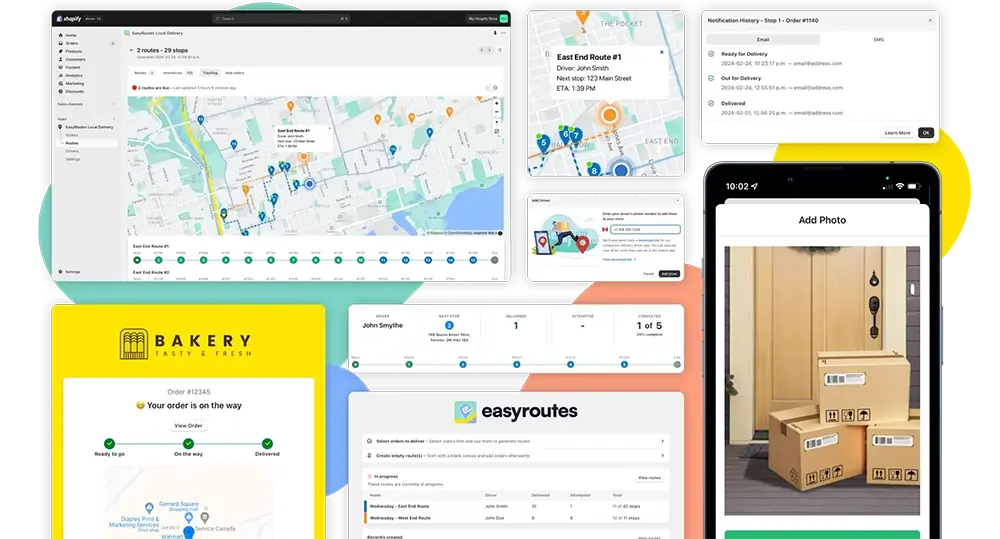
The system continuously recalculates routes during the day, adapting to new circumstances as they arise. For example, if heavy traffic builds up on a driver’s route, ORION can instantly reroute to avoid delays. If a customer updates their delivery preference mid-day, the system integrates this new information into the optimized schedule. These AI in eCommerce examples highlight how artificial intelligence transforms route planning from static to dynamic, ensuring flexibility and efficiency.
The business impact of ORION has been extraordinary. UPS estimates that the system saves the company millions of gallons of fuel annually and eliminates thousands of metric tons of CO₂ emissions by reducing unnecessary miles. Each mile saved translates into significant cost savings at scale, making AI-powered route optimization both an economic and environmental win. For customers, this means faster, more reliable deliveries, reinforcing trust in the UPS brand. These AI in eCommerce examples underline the importance of intelligence in achieving operational excellence in last-mile delivery.
DHL predictive routing with machine learning
Another strong case among AI in eCommerce examples comes from DHL, which uses machine learning to drive predictive routing in its global logistics network. DHL operates in more than 220 countries, managing an extraordinarily complex web of deliveries. To maintain efficiency, the company employs AI systems that analyze historical data, real-time inputs, and predictive analytics to optimize delivery routes.

Unlike traditional systems that simply respond to immediate conditions, DHL’s predictive routing anticipates problems before they occur. For example, by analyzing weather forecasts, traffic trends, and regional delivery volumes, the AI can predict potential bottlenecks and reroute shipments proactively. Machine learning models also incorporate lessons from past disruptions, continuously improving accuracy over time. These AI in eCommerce examples demonstrate how predictive intelligence moves logistics from reactive problem-solving to proactive planning.
One of the standout features of DHL’s system is its ability to balance efficiency with customer experience. Predictive routing ensures deliveries arrive on time while minimizing fuel consumption and driver overtime. In addition, DHL can provide customers with more precise delivery windows, reducing the frustration of vague “out for delivery” notifications. These AI in eCommerce examples highlight how machine learning not only improves operations but also enhances transparency and customer satisfaction—two essential components of modern eCommerce.
Result: Reduced costs and faster deliveries
The overarching benefit of these AI in eCommerce examples is the combination of reduced operational costs and faster deliveries. Last-mile delivery is often the single most expensive element of fulfillment, accounting for up to 50% of total logistics costs. AI-driven route optimization dramatically lowers these costs by reducing mileage, improving fuel efficiency, and maximizing driver productivity. At scale, even small improvements per route translate into millions of dollars in annual savings.
For example, UPS’s ORION system reduces an estimated 100 million miles driven per year, creating both financial savings and environmental benefits. DHL’s predictive routing minimizes wasted time and fuel by avoiding traffic snarls and optimizing delivery density. These AI in eCommerce examples illustrate how artificial intelligence not only streamlines operations but also contributes to sustainability goals—an increasingly important factor for retailers and consumers alike.

Faster deliveries are equally critical. In a world where same-day and next-day shipping are becoming the norm, the ability to shave minutes or hours off delivery times can determine whether a customer stays loyal or switches to a competitor. AI ensures that routes are continuously optimized, reducing delays and enabling faster service without requiring additional resources. These AI in eCommerce examples show how businesses can meet rising consumer expectations while maintaining profitability.
The customer experience benefits are clear. Reliable, fast deliveries build trust and increase the likelihood of repeat purchases. When shoppers know their orders will arrive on time, they are more confident in buying again, and positive experiences often lead to referrals and stronger brand advocacy. These AI in eCommerce examples prove that route optimization is not just about logistics efficiency—it is about creating a superior customer journey that drives long-term growth.
Drone & autonomous delivery
One of the most futuristic yet increasingly practical applications of artificial intelligence in retail logistics lies in drone and autonomous delivery. The last mile has always been the most expensive and complicated part of fulfillment, often accounting for nearly half of total shipping costs. Traffic congestion, limited driver availability, and rising fuel prices exacerbate these challenges, especially as customers demand faster, cheaper, and more reliable delivery options. Among the most disruptive AI in eCommerce examples are those where drones and autonomous vehicles are deployed to reshape last-mile delivery.

AI plays a central role in making drone and autonomous delivery feasible. These vehicles must perceive their environments, make real-time decisions, and interact safely with both infrastructure and people. Machine learning, computer vision, and predictive analytics allow drones to navigate obstacles, avoid collisions, and land safely, while autonomous ground vehicles plan optimal routes and adjust instantly to changing traffic conditions. These AI in eCommerce examples demonstrate that artificial intelligence is not just a backend optimization tool—it is the enabling force behind entirely new delivery paradigms.
Amazon Prime Air drone initiative
One of the most high-profile AI in eCommerce examples of drone delivery is Amazon Prime Air. Amazon has been testing drone-based fulfillment for over a decade, envisioning a future where small packages can be delivered within 30 minutes of purchase. The drones are designed to carry packages up to five pounds—encompassing the majority of Amazon’s orders—and deliver them directly to customers’ backyards.
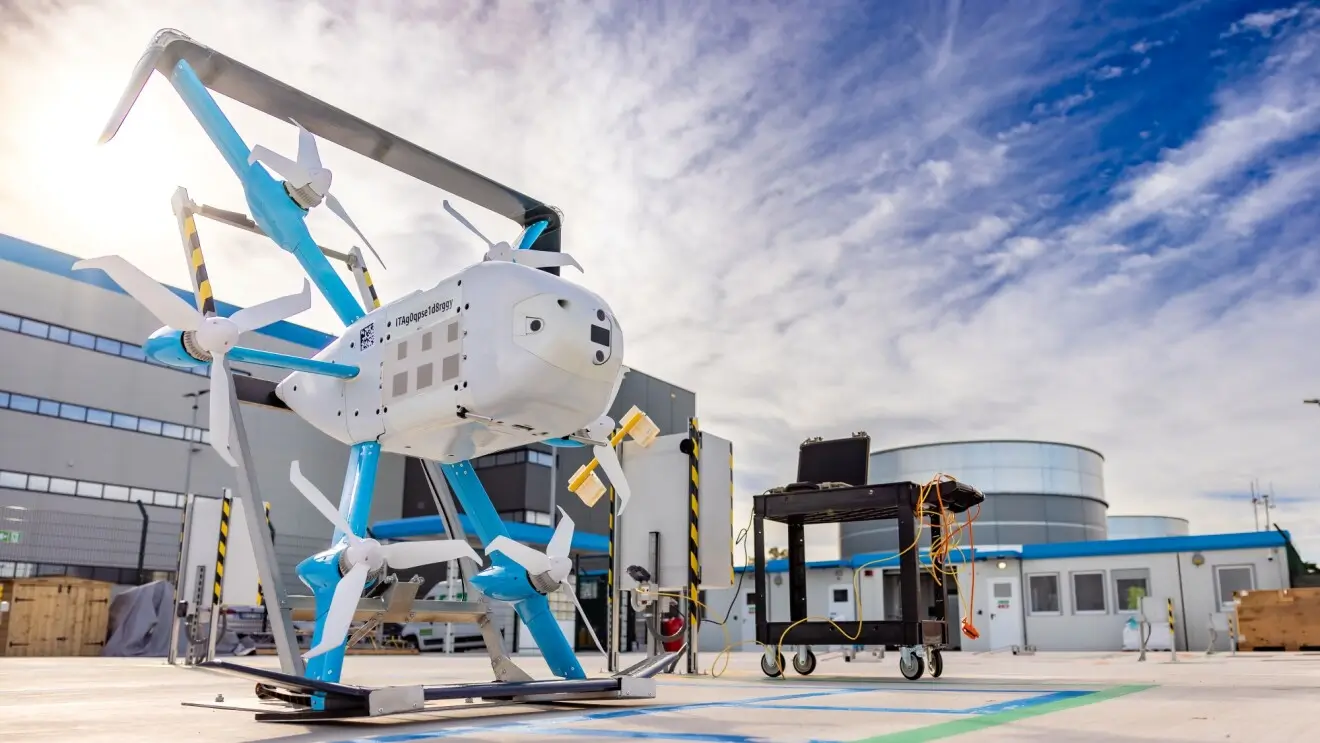
The AI embedded in Prime Air drones enables them to fly autonomously, relying on computer vision and onboard sensors to detect obstacles such as trees, power lines, and animals. Predictive algorithms calculate safe flight paths, while adaptive learning systems allow the drones to improve their performance with every flight. These AI in eCommerce examples highlight how intelligence is critical for enabling autonomous flight in complex, real-world environments.
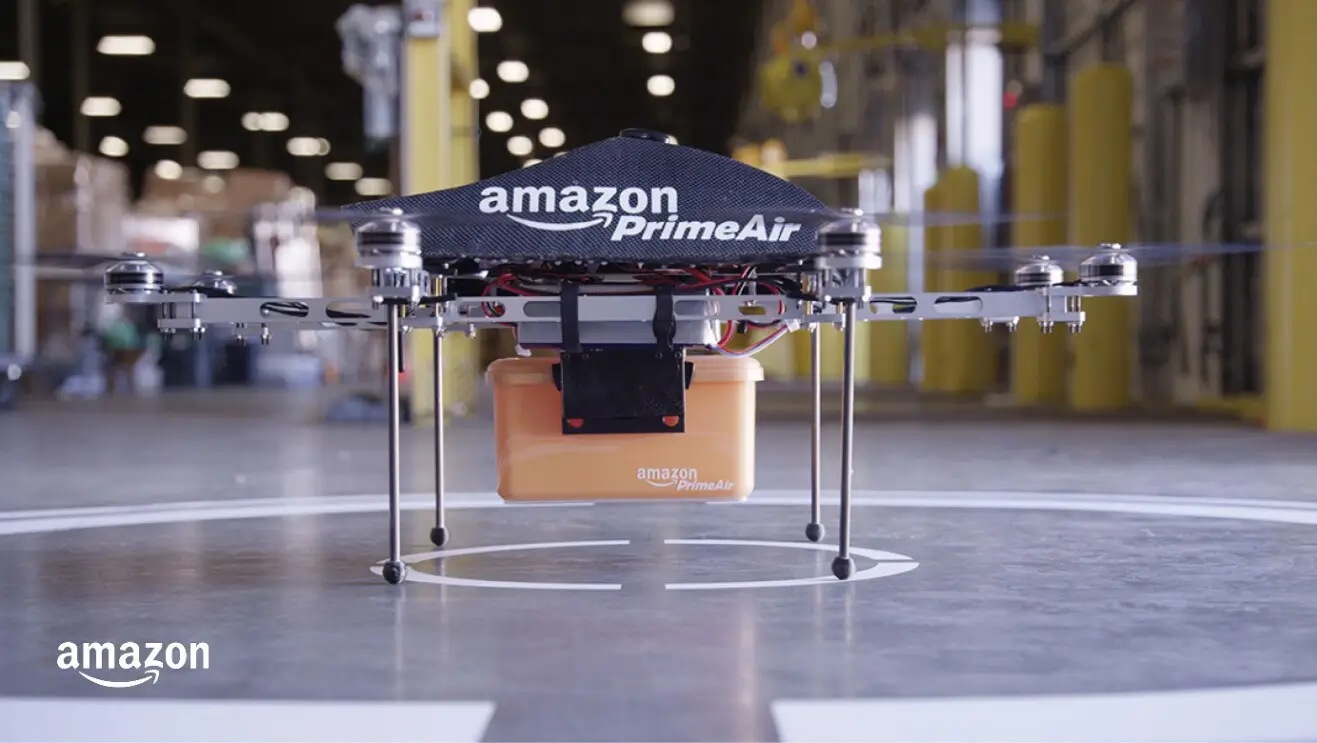
Beyond navigation, AI also manages logistics coordination. When a customer places an order eligible for drone delivery, the system determines whether local weather, airspace regulations, and fulfillment center capacity make it feasible. If conditions are met, the AI schedules the drone dispatch, ensuring efficient use of the fleet. These AI in eCommerce examples illustrate how AI integrates decision-making across systems, from flight control to customer communication.
While Prime Air has not yet scaled globally, Amazon has begun limited trials in the United States and other regions, proving the concept’s viability. If scaled, the initiative could redefine consumer expectations for delivery, turning same-day service into same-hour convenience. These AI in eCommerce examples demonstrate the transformative potential of drones to eliminate many of the constraints of traditional last-mile delivery.
JD.com autonomous vehicles in China
Another compelling case among AI in eCommerce examples comes from JD.com, one of China’s largest online retailers. JD.com has invested heavily in autonomous delivery vehicles—small, self-driving vans that navigate city streets to deliver parcels directly to customers. These vehicles represent a ground-based counterpart to Amazon’s drones, designed to handle larger payloads and operate in dense urban environments.
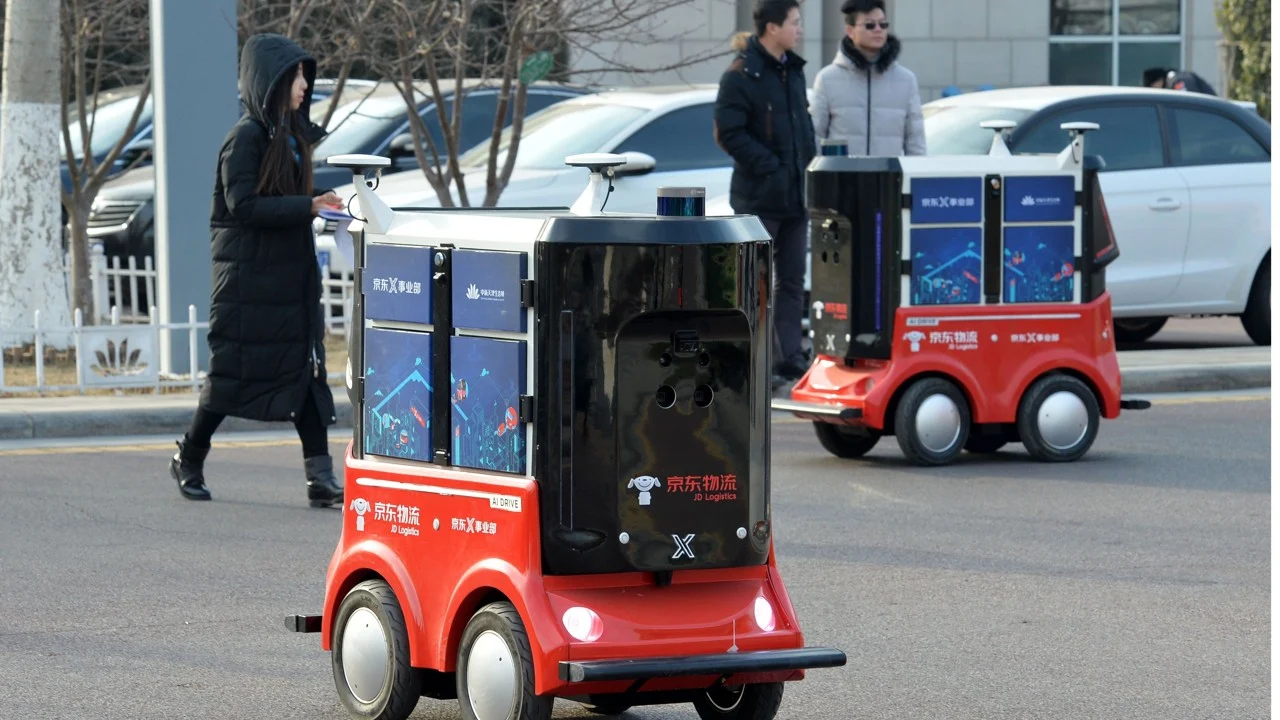
AI enables these vehicles to perceive their surroundings through a combination of sensors, LiDAR, cameras, and GPS. Machine learning algorithms interpret traffic patterns, recognize pedestrians, and plan safe routes. When encountering obstacles like parked cars or construction zones, the vehicles can reroute autonomously, demonstrating adaptive intelligence in real-world conditions. These AI in eCommerce examples show how machine learning transforms vehicles into safe, reliable delivery agents.
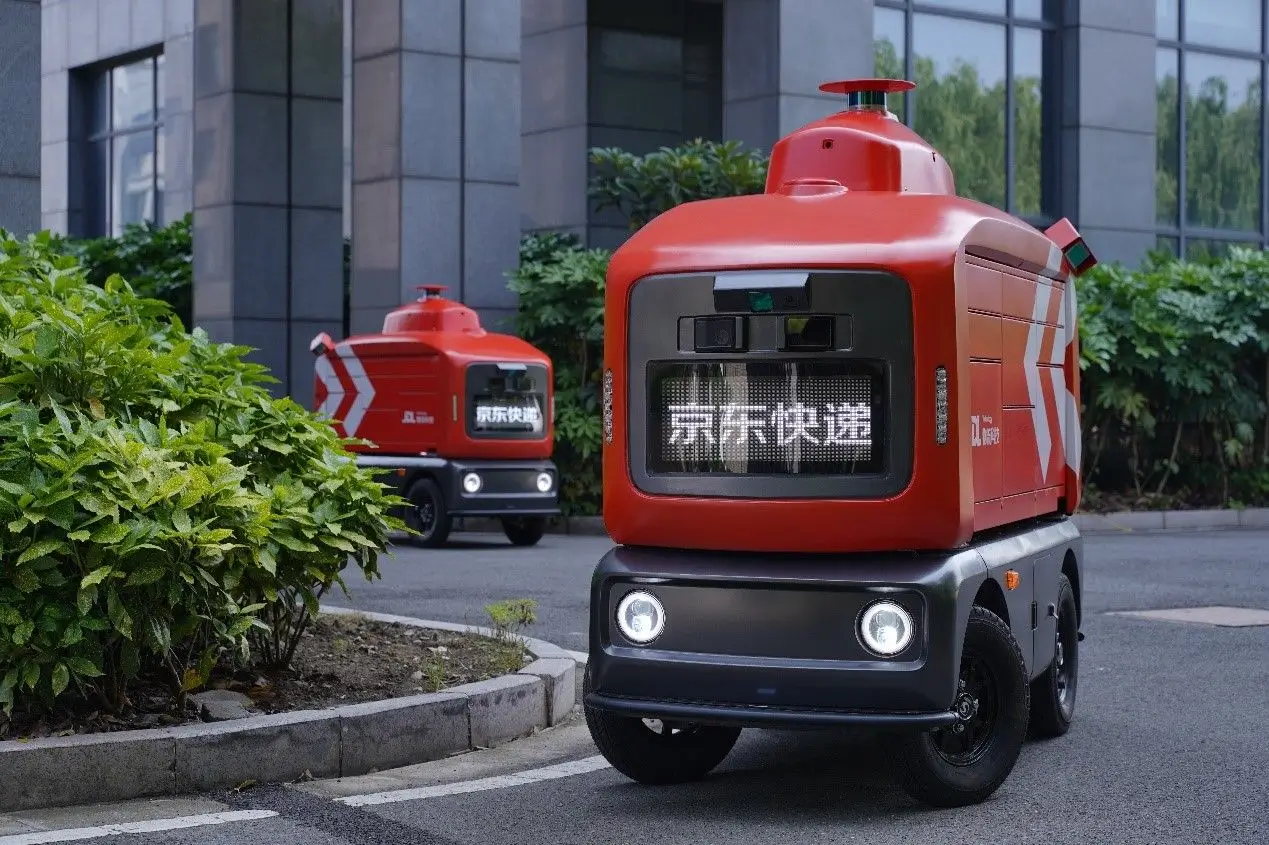
JD.com’s autonomous vehicles also integrate with the retailer’s broader logistics network. The AI platform predicts demand by analyzing order volumes, then deploys vehicles where they are most needed. Customers receive notifications when the vehicle arrives, and they can retrieve packages using codes or facial recognition systems. These AI in eCommerce examples highlight how AI streamlines every stage of the delivery process, from demand forecasting to customer interaction.
Trials across Chinese cities have shown promising results, with JD.com’s autonomous vehicles handling thousands of deliveries daily in designated zones. These AI in eCommerce examples illustrate how ground-based autonomy complements other logistics innovations, reducing reliance on human drivers and lowering last-mile delivery costs.
Result: Reshaping last-mile delivery
The most significant impact of these AI in eCommerce examples is their potential to completely reshape last-mile delivery. Traditional delivery models are limited by human labor availability, traffic congestion, and infrastructure costs. Drones and autonomous vehicles, powered by AI, bypass many of these constraints by offering flexible, scalable, and efficient alternatives.
From a cost perspective, autonomous delivery reduces dependence on human drivers, who account for a large portion of logistics expenses. AI-driven drones and vehicles operate around the clock, requiring minimal downtime, and can complete deliveries faster than traditional methods. These AI in eCommerce examples show how automation directly translates into lower costs and improved scalability for retailers.

From a customer perspective, AI-driven delivery enhances convenience and satisfaction. Drones can deliver packages within minutes, while autonomous vehicles provide precise delivery windows and reduce the frustration of missed deliveries. These AI in eCommerce examples underline the direct connection between intelligent logistics and stronger customer loyalty.
Environmental benefits are also noteworthy. By optimizing routes and replacing traditional delivery vans with electric drones or autonomous vehicles, these AI in eCommerce examples contribute to reduced emissions and more sustainable operations. Retailers adopting these technologies can align with consumer expectations for eco-friendly commerce while cutting costs.
Finally, the scalability of AI-powered delivery opens new possibilities for rural and underserved areas. Where traditional logistics infrastructure struggles due to distance or cost, drones and autonomous vehicles can fill the gap, expanding access to fast, reliable delivery. These AI in eCommerce examples prove that the technology not only benefits urban centers but also has the potential to democratize eCommerce globally.
Returns optimization
Returns have become one of the thorniest challenges in modern retail. As eCommerce expands, the rate of returns continues to rise, particularly in categories like fashion and footwear, where customers often order multiple sizes or styles with the intention of sending some back. While free and easy returns may boost initial sales, they also create enormous logistical costs, inventory complications, and environmental waste. Among the most valuable AI in eCommerce examples are those that focus on optimizing returns—using artificial intelligence to predict, prevent, and manage the process more efficiently.

Traditional return management has often been reactive. Retailers simply accepted returns as a cost of doing business and tried to minimize the damage through policies or manual inspections. But artificial intelligence allows businesses to be proactive, reducing return rates before they occur and streamlining logistics when returns are unavoidable. These AI in eCommerce examples show how predictive analytics, machine learning, and customer behavior modeling are being used by leading retailers like ASOS and Zappos to minimize returns, cut costs, and improve sustainability.
ASOS AI predicting likelihood of returns
One of the most prominent AI in eCommerce examples of returns optimization comes from ASOS, the UK-based online fashion retailer. With a massive global customer base and a product catalog spanning thousands of styles, ASOS faces high return rates typical of the apparel industry. Customers often order multiple sizes to try at home, or they return items that don’t match expectations from online photos. To tackle this issue, ASOS deployed AI systems that predict the likelihood of returns at both the product and customer levels.
These AI models analyze vast amounts of data, including customer purchase histories, return patterns, browsing behavior, and even metadata from product descriptions. For instance, if a customer has repeatedly returned shoes ordered online due to size issues, the system can flag this behavior and recommend more precise sizing guidance during future purchases. Similarly, AI can identify which product categories or styles are most frequently returned and alert the merchandising team to investigate potential issues with quality, sizing, or product imagery.

These AI in eCommerce examples highlight how predictive modeling reduces return rates by intervening before a purchase is made. Customers might be shown size recommendations tailored to their past behavior or receive warnings if they are about to order multiple versions of a product they frequently return. For ASOS, this means fewer unnecessary returns, lower costs, and improved customer satisfaction, as buyers are guided toward choices that are more likely to work for them.
The business impact is significant. Each avoided return saves shipping costs, reduces labor in processing, and prevents merchandise from being marked down or discarded. These AI in eCommerce examples prove that proactive return management powered by AI is a strategic lever for profitability in industries with inherently high return rates.
Zappos using AI to minimize return rates
Another compelling illustration among AI in eCommerce examples comes from Zappos, the US-based online shoe and apparel retailer famous for its customer-centric policies. While Zappos built its reputation on free and hassle-free returns, it also recognized that high return rates could undermine profitability and create waste. To address this, Zappos integrated AI into its operations to minimize return rates without sacrificing customer satisfaction.
Zappos uses AI to analyze customer reviews, return comments, and product attributes to understand why items are returned. For instance, if a particular shoe style receives consistent feedback about running small, the AI system detects this pattern quickly and updates product descriptions to include size warnings or recommendations to order a half-size larger. These AI in eCommerce examples show how machine learning converts customer feedback into actionable insights that reduce repeat mistakes.

In addition, Zappos applies AI to personalize recommendations. By studying individual customer behavior—such as preferred brands, past successful purchases, and style choices—the system suggests products that are less likely to be returned. For example, if a customer has consistently purchased sneakers from a certain brand without returning them, Zappos’ AI will prioritize similar products in future recommendations. These AI in eCommerce examples illustrate how personalization, powered by AI, leads to higher satisfaction and fewer returns.
The outcome is a more efficient balance between generous return policies and sustainable profitability. Customers still enjoy the flexibility of free returns, but the likelihood of needing to use that option decreases significantly. This strengthens loyalty while simultaneously lowering logistical costs, proving that AI-driven optimization benefits both the customer and the retailer.
Result: Higher profitability and reduced waste
The overarching outcome of these AI in eCommerce examples is clear: optimized returns lead directly to higher profitability and reduced waste. Returns are one of the most expensive aspects of eCommerce operations, with costs that include reverse logistics, restocking, repackaging, and potential markdowns. By predicting and preventing unnecessary returns, AI reduces the financial burden and preserves margins. For companies like ASOS and Zappos, even modest reductions in return rates translate into millions of dollars in annual savings.
Beyond financial performance, these AI in eCommerce examples also highlight important sustainability gains. Overstock and high returns often result in products being discarded, contributing to landfill waste and carbon emissions. By ensuring that customers receive the right product the first time, AI reduces waste and supports more sustainable consumption. For environmentally conscious consumers, this alignment strengthens brand loyalty and trust.

Customer experience also improves. Shoppers guided by AI toward better product matches experience fewer disappointments and hassles with returns. This creates a virtuous cycle: satisfied customers are more likely to repurchase, leave positive reviews, and recommend the retailer to others. These AI in eCommerce examples demonstrate that returns optimization is not just a cost-saving exercise but a driver of loyalty and growth.
Strategically, the ability to manage returns intelligently gives retailers a competitive edge. Many companies hesitate to offer generous return policies because of the costs involved. However, with AI reducing the actual frequency of returns, businesses can provide customer-friendly policies without compromising profitability. These AI in eCommerce examples prove that artificial intelligence bridges the gap between customer expectations and business sustainability.
AI in Fraud Detection & Security
AI systems excel at continuously learning from new data, which is critical in combating fraud. Every fraudulent attempt contributes to training models that become more accurate at detecting future threats. By examining hundreds of variables simultaneously—such as transaction history, device fingerprints, geolocation, and behavioral biometrics—AI can instantly assess risk and decide whether to approve, decline, or flag a transaction for review. These AI in eCommerce examples show how fraud detection powered by AI minimizes financial losses, reduces customer friction, and builds trust in digital commerce.
Fraud prevention in payments
Payment fraud is one of the most persistent threats in online commerce. Every transaction carries the potential risk of stolen credit cards, account takeovers, or malicious attempts to exploit vulnerabilities in payment gateways. For merchants, the consequences can be severe: financial losses from chargebacks, penalties from payment processors, and reputational damage that erodes consumer trust. Customers, too, face the risk of compromised personal data and unauthorized charges. Among the most critical AI in eCommerce examples are those that apply artificial intelligence to fraud prevention in payments, ensuring transactions remain secure while maintaining a smooth customer experience.

Traditional fraud prevention relied on static rules such as declining transactions from certain IP addresses or flagging unusually large purchases. While these rules-based systems provided a first line of defense, they often produced high levels of false positives, blocking legitimate transactions and frustrating customers. Worse, they frequently failed to detect sophisticated fraud schemes that evolve rapidly. Artificial intelligence fundamentally improves this process by analyzing patterns across millions of transactions, identifying subtle anomalies, and adapting in real time. These AI in eCommerce examples show how payment fraud prevention powered by AI protects merchants and customers at scale.
PayPal AI fraud detection at scale
One of the most established AI in eCommerce examples of fraud prevention comes from PayPal, which processes billions of transactions annually across its global platform. With such scale, even a tiny percentage of fraudulent transactions could translate into massive losses. To combat this, PayPal employs advanced AI and machine learning algorithms that analyze transactions in real time.
PayPal’s AI models evaluate hundreds of variables simultaneously: transaction size, purchase frequency, device fingerprints, IP addresses, geographic location, and user behavior patterns. If a purchase deviates from established norms—such as an account suddenly making high-value purchases from an unfamiliar country—the system can instantly flag or block it. These AI in eCommerce examples highlight how machine learning enables fraud detection systems to evolve continuously, learning from both legitimate and fraudulent transactions to improve accuracy over time.

The scale of PayPal’s AI is remarkable. Every second, the platform analyzes millions of data points across global transactions. This allows PayPal to detect emerging fraud schemes quickly, adapting faster than criminals can adjust their tactics. These AI in eCommerce examples demonstrate that AI not only enhances security but also ensures the platform can handle massive transaction volumes without compromising safety.
Importantly, PayPal’s AI systems are designed to minimize friction for legitimate customers. By analyzing context and behavioral signals, the AI reduces false positives, allowing most transactions to proceed without interruption. This balance between security and convenience is one of the most significant advantages of AI in fraud prevention. Customers feel protected without experiencing unnecessary declines or verification hurdles, while merchants avoid lost sales caused by false fraud flags.
Stripe Radar machine learning fraud protection
Another leading case among AI in eCommerce examples is Stripe Radar, the fraud prevention system built into the Stripe payments platform. Stripe processes payments for millions of online businesses, from small startups to global enterprises, and its Radar system uses machine learning to protect them from fraud.
Stripe Radar leverages data from the vast Stripe network, which processes transactions across industries and geographies. This global dataset provides powerful insights into fraud patterns, enabling Radar to detect suspicious activity that might not be visible to a single merchant. For example, if fraudsters attempt to use the same stolen credit card across multiple websites, Stripe Radar can identify the pattern and block the transaction in real time. These AI in eCommerce examples show how shared intelligence strengthens fraud protection across the entire ecosystem.
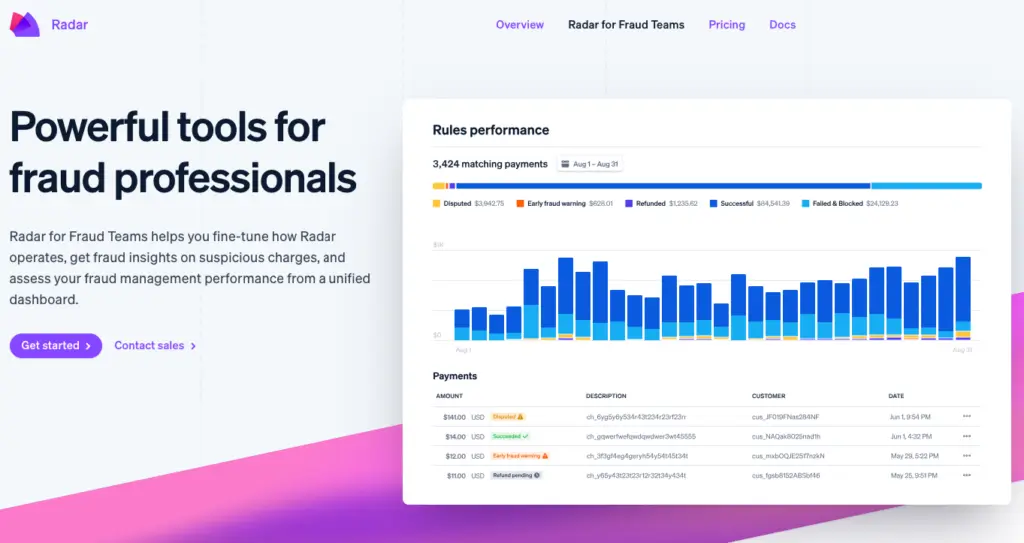
The AI models powering Radar continuously learn from both confirmed fraud attempts and legitimate transactions. Merchants can also provide feedback, flagging transactions as fraudulent or safe, which further improves accuracy. These AI in eCommerce examples illustrate how collaborative machine learning creates a virtuous cycle: the more data Radar processes, the better it becomes at predicting and preventing fraud.
Stripe Radar also provides merchants with customizable tools, such as risk scoring and rule creation, built on top of AI predictions. This allows businesses to tailor fraud prevention to their specific risk tolerance. For example, a high-ticket luxury retailer might adopt stricter thresholds, while a fast-moving fashion brand may prioritize customer convenience. These AI in eCommerce examples highlight how AI fraud detection systems can be both standardized and flexible, meeting diverse merchant needs without sacrificing protection.
Result: Protecting merchants & customers in real time
The overarching outcome of these AI in eCommerce examples is the real-time protection of both merchants and customers. Payment fraud evolves too quickly for manual review or static systems to keep pace. AI ensures that every transaction is assessed instantly, balancing security with customer experience. By catching fraud before it occurs, merchants avoid costly chargebacks, penalties, and reputational harm. Customers benefit from knowing their data and money are secure, increasing confidence in online shopping.
Real-time fraud prevention powered by AI also contributes to higher profitability. False positives—legitimate transactions mistakenly blocked as fraudulent—can cost retailers millions in lost sales and damage customer trust. These AI in eCommerce examples show how machine learning reduces false positives by distinguishing between unusual but legitimate behavior and genuinely suspicious activity. For instance, a loyal customer making a large purchase while traveling abroad may be flagged by a rules-based system, but AI can recognize contextual signals that validate the transaction.

The scalability of AI is another critical factor. As eCommerce grows globally, the volume of transactions continues to skyrocket. Human fraud analysts cannot possibly review millions of payments per second. These AI in eCommerce examples demonstrate how artificial intelligence scales effortlessly, processing massive datasets without compromising accuracy. This scalability ensures that fraud detection systems remain effective even during peak shopping events like Black Friday or Singles’ Day.
Beyond direct fraud prevention, AI strengthens trust in digital commerce ecosystems. Merchants that use platforms like PayPal and Stripe benefit from the credibility these systems provide. Customers are more likely to shop with businesses that are perceived as secure, driving higher conversion rates and repeat purchases. These AI in eCommerce examples underline that fraud prevention is not just a back-end necessity—it is a front-end driver of customer confidence and loyalty.
Account & identity verification
One of the fastest-growing concerns in digital commerce is account fraud and identity theft. As more shoppers create accounts and store sensitive payment information online, the risk of account takeovers, fake account creation, and fraudulent identity use has risen dramatically. Retailers must verify that customers are who they say they are without adding unnecessary friction that drives them away. Among the most important AI in eCommerce examples are those that focus on account and identity verification, where artificial intelligence balances security with convenience to create safe, seamless shopping experiences.

In the past, identity verification often relied on static methods such as passwords, one-time PINs, or manual checks. While functional, these approaches have become increasingly inadequate in the face of sophisticated fraud schemes. Passwords are easily stolen, and manual verification is too slow to keep pace with the scale of global eCommerce. Artificial intelligence introduces dynamic, context-aware solutions that evaluate each transaction and account in real time. These AI in eCommerce examples show how Mastercard and Shopify, among others, deploy machine learning to reduce fraud, minimize false positives, and ensure secure transactions.
Mastercard AI authentication for online transactions
One of the most prominent AI in eCommerce examples of account and identity verification comes from Mastercard, which uses artificial intelligence to authenticate online transactions at scale. Mastercard’s AI systems analyze each transaction in milliseconds, evaluating hundreds of signals simultaneously to determine whether the purchaser is legitimate.
The system takes into account variables such as device fingerprinting, IP address, geolocation, spending patterns, and behavioral biometrics like typing speed or navigation habits. If a transaction deviates from the customer’s usual behavior—say, an unusually high-value purchase from a foreign location—the AI assigns a higher risk score. Merchants and issuers can then decide whether to approve, decline, or request additional authentication. These AI in eCommerce examples highlight how Mastercard leverages AI not only to detect suspicious activity but also to allow legitimate customers to shop with minimal friction.

Mastercard’s approach is built around adaptive learning. The AI continuously refines its models as it processes billions of transactions worldwide, learning from both confirmed fraud attempts and legitimate purchases. This allows it to respond to emerging fraud tactics faster than rules-based systems ever could. These AI in eCommerce examples demonstrate how large-scale networks benefit from the feedback loop of real-time data, creating stronger protections over time.
Another key benefit is the reduction of false positives. Traditional fraud detection systems often blocked legitimate transactions, frustrating customers and leading to lost sales. Mastercard’s AI reduces this by considering broader contextual signals and making more nuanced decisions. For shoppers, this means fewer unnecessary declines, while for merchants it means higher conversion rates and stronger trust in the payment process. These AI in eCommerce examples prove that authentication powered by AI enhances both security and the customer experience.
Shopify built-in fraud analysis for stores
Another strong case among AI in eCommerce examples is Shopify’s built-in fraud analysis, which provides merchants with AI-driven tools to verify account authenticity and detect suspicious transactions. Shopify serves millions of businesses worldwide, many of them small or medium-sized retailers without the resources to build advanced fraud detection systems. By integrating AI fraud analysis into its platform, Shopify democratizes access to enterprise-grade security.
Shopify’s fraud analysis uses machine learning to assess risk factors for each order, such as mismatched billing and shipping addresses, unusual purchase volumes, or flagged email addresses. Merchants receive risk scores and detailed indicators, enabling them to make informed decisions about whether to fulfill, review, or cancel an order. These AI in eCommerce examples show how AI empowers even small businesses to combat fraud effectively.
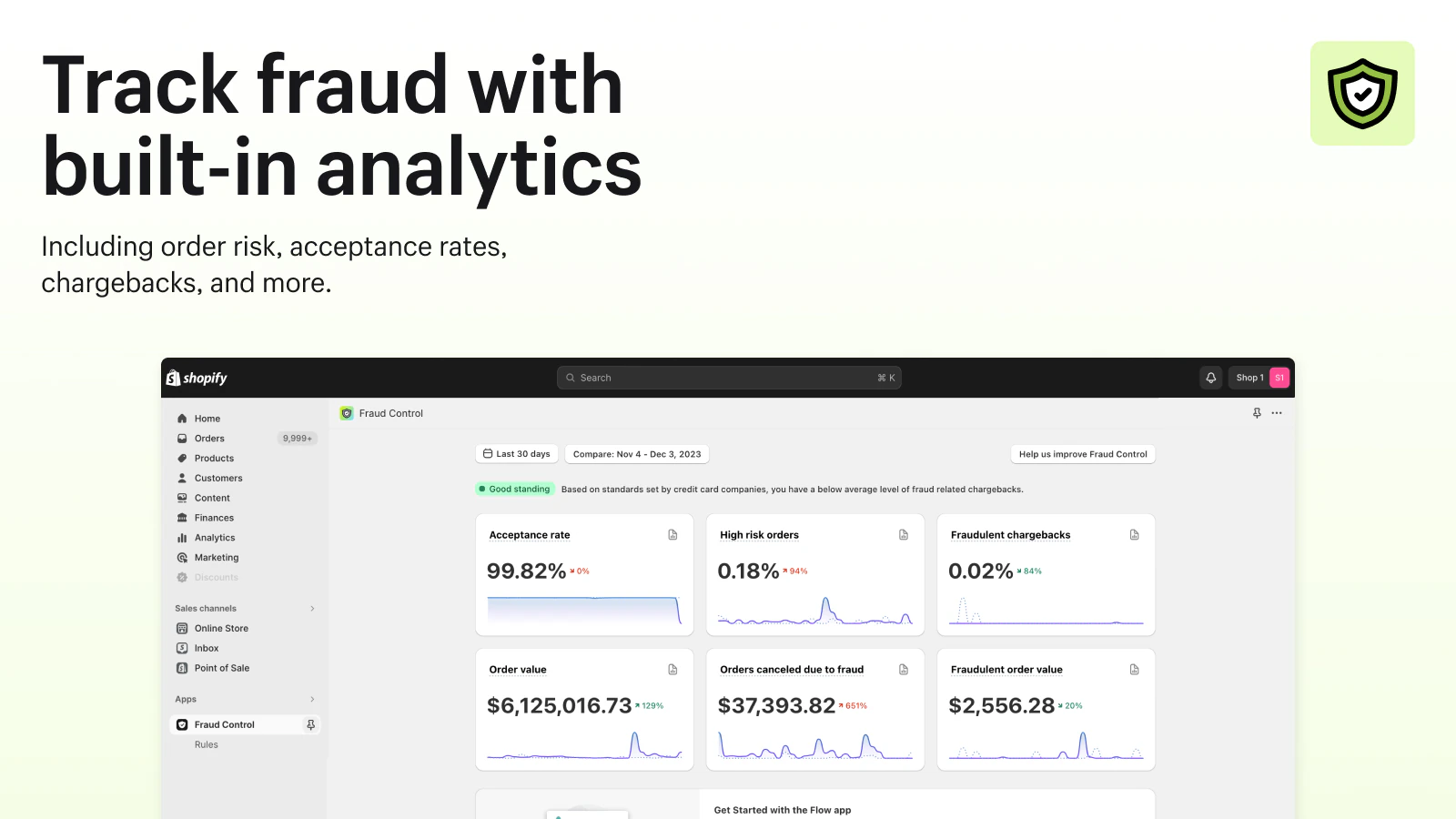
What sets Shopify’s system apart is its ease of use. Merchants can review risk analyses directly in their dashboards without needing technical expertise. AI handles the complex work of analyzing patterns and scoring risks, while retailers simply act on the recommendations. These AI in eCommerce examples highlight how artificial intelligence can simplify complex processes, making fraud detection accessible at scale.
Shopify also integrates AI-driven verification with its payments ecosystem. If a transaction is deemed suspicious, the system can hold funds or require additional steps before releasing them. For customers, this creates a secure environment where account fraud is less likely. For merchants, it reduces the risk of chargebacks and the associated financial penalties. These AI in eCommerce examples illustrate how built-in fraud analysis contributes to safer transactions across an entire ecosystem of online stores.
Result: Secure transactions with reduced false positives
The combined impact of these AI in eCommerce examples—Mastercard’s global AI authentication and Shopify’s built-in fraud analysis—demonstrates how artificial intelligence secures transactions while minimizing disruptions to legitimate customers. In payment security, false positives can be almost as damaging as fraud itself. Every time a valid transaction is blocked, merchants lose revenue and risk alienating customers. AI addresses this by making more precise, context-aware decisions in real time.
For merchants, the benefits are significant. Fewer false positives mean more completed transactions, higher sales, and better customer retention. For customers, the experience is smoother, as they can shop confidently without unexpected declines or cumbersome authentication hurdles. These AI in eCommerce examples show that secure transactions need not come at the expense of convenience—a balance that static, rules-based systems could never achieve.

Another critical outcome is scalability. Global eCommerce transactions number in the billions each day, far beyond what manual fraud analysts could ever review. AI enables systems like Mastercard’s authentication platform and Shopify’s fraud analysis to evaluate massive transaction volumes instantly, providing security at scale. These AI in eCommerce examples underscore the necessity of AI in maintaining trust and efficiency in digital marketplaces.
Moreover, AI strengthens the overall relationship between customers and merchants. When shoppers trust that their accounts and identities are protected, they are more likely to engage in repeat purchases and share sensitive information like saved payment methods. These AI in eCommerce examples highlight how effective identity verification fosters loyalty and drives long-term growth.
Real-time anomaly detection
Fraud in eCommerce is not only widespread but also highly dynamic. Criminals continuously refine their tactics, exploiting peak sales events, seasonal promotions, and global shopping holidays when transaction volumes are at their highest. Traditional systems, which rely on static fraud rules or manual reviews, struggle to keep up with the velocity and complexity of modern fraud attempts. This is where real-time anomaly detection—powered by artificial intelligence—becomes indispensable. Among the most impactful AI in eCommerce examples are those where anomaly detection systems analyze billions of transactions instantly, flagging suspicious activities before they result in losses.

Anomaly detection is the process of identifying behaviors or events that deviate from normal patterns. In payments and online shopping, these anomalies might include unusually high purchase amounts, sudden spikes in activity from a single account, or abnormal ordering behavior from new devices. Unlike rules-based systems that require pre-set thresholds, AI-powered anomaly detection uses machine learning to recognize complex, evolving fraud signals. These AI in eCommerce examples show how real-time monitoring reduces fraud risk, minimizes false positives, and ensures secure transactions even during massive peaks in online sales.
Alibaba during Singles’ Day handling billions of transactions
One of the most powerful AI in eCommerce examples of real-time anomaly detection comes from Alibaba during its annual Singles’ Day shopping festival. Singles’ Day, held on November 11th, has grown into the largest online shopping event in the world, with sales volumes surpassing those of Black Friday and Cyber Monday combined. In a 24-hour period, Alibaba processes billions of transactions across its platforms, creating an enormous target for fraudsters attempting to exploit the surge in activity.
To protect merchants and customers, Alibaba deploys AI systems capable of analyzing every transaction in real time. These systems monitor behavioral signals, payment histories, device fingerprints, and geolocation data, comparing them against patterns of legitimate behavior. If a transaction appears unusual—for example, a new account placing dozens of high-value orders within minutes—the AI system flags it instantly for review or blocks it outright. These AI in eCommerce examples highlight the necessity of machine learning when manual review is impossible due to scale.
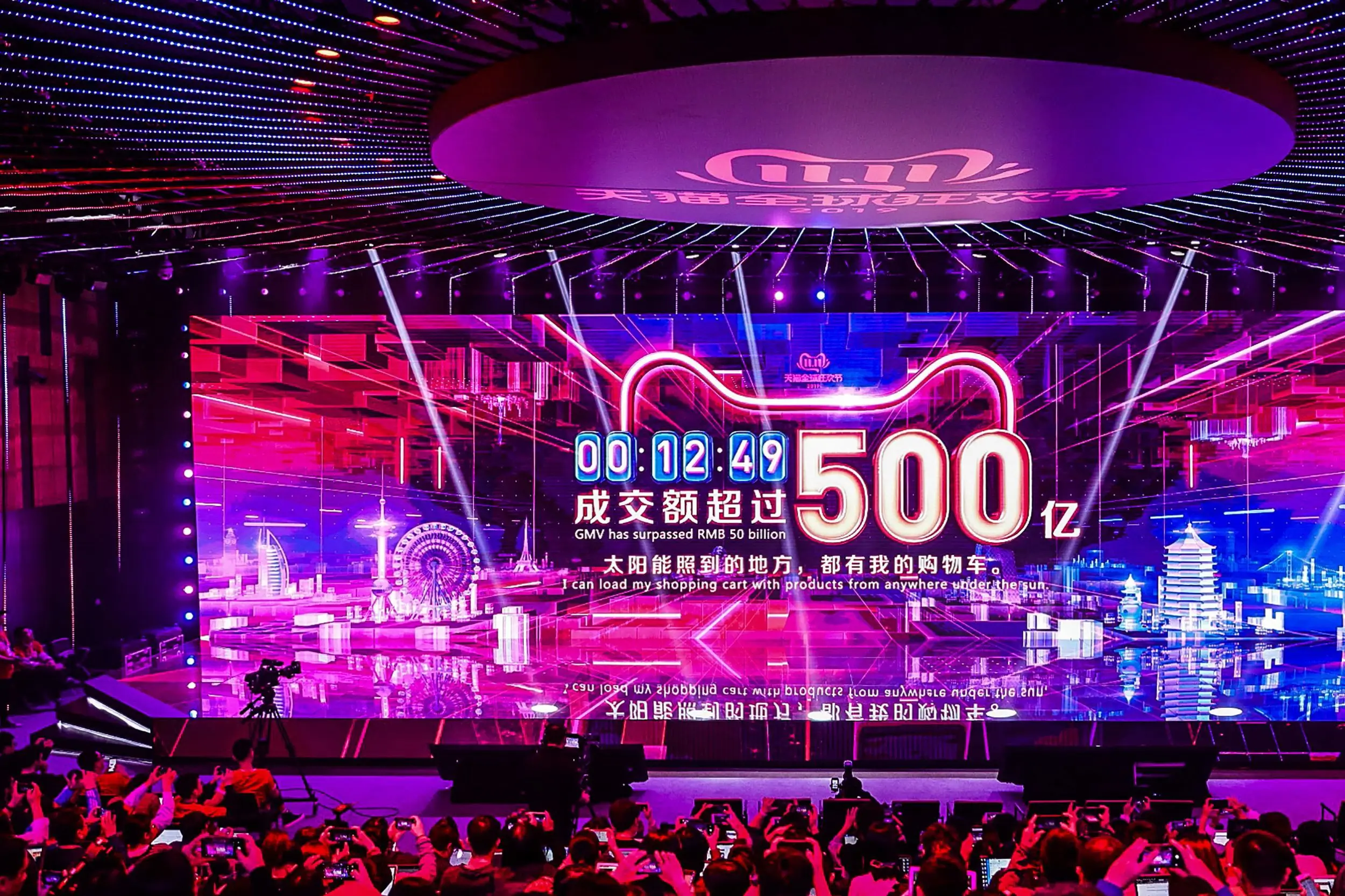
The AI models used by Alibaba are also self-learning. Each year, fraud attempts during Singles’ Day provide new data points that refine the system’s accuracy for the next event. By continuously training on billions of data samples, Alibaba’s fraud detection system evolves to recognize subtle, emerging tactics used by cybercriminals. These AI in eCommerce examples illustrate how anomaly detection becomes smarter with scale, ensuring protection improves in tandem with growing transaction volumes.
The results are impressive. Alibaba reports massive reductions in fraudulent transactions, maintaining customer trust during one of the most high-pressure events in global retail. Without AI, it would be impossible to secure such a large-scale shopping festival while ensuring that legitimate purchases are processed smoothly. These AI in eCommerce examples prove that anomaly detection is essential for protecting not only revenue but also brand reputation during record-breaking sales events.
EBay AI models for spotting unusual purchase patterns
Another compelling example among AI in eCommerce examples is eBay’s use of AI models to detect unusual purchase patterns across its vast marketplace. With millions of active buyers and sellers worldwide, eBay is particularly vulnerable to fraud schemes involving fake accounts, coordinated scams, or abnormal purchase activity. To combat these threats, eBay relies on anomaly detection models that analyze behavioral data in real time.
These models monitor account activity for deviations from normal behavior. For instance, if a buyer account that typically purchases low-value household items suddenly begins placing bulk orders for expensive electronics, the AI system flags it as anomalous. Similarly, if multiple accounts are created and all begin purchasing from the same seller within a short time frame, this might indicate a fraudulent scheme. These AI in eCommerce examples show how anomaly detection can reveal not just isolated incidents but also coordinated fraud patterns across an entire ecosystem.
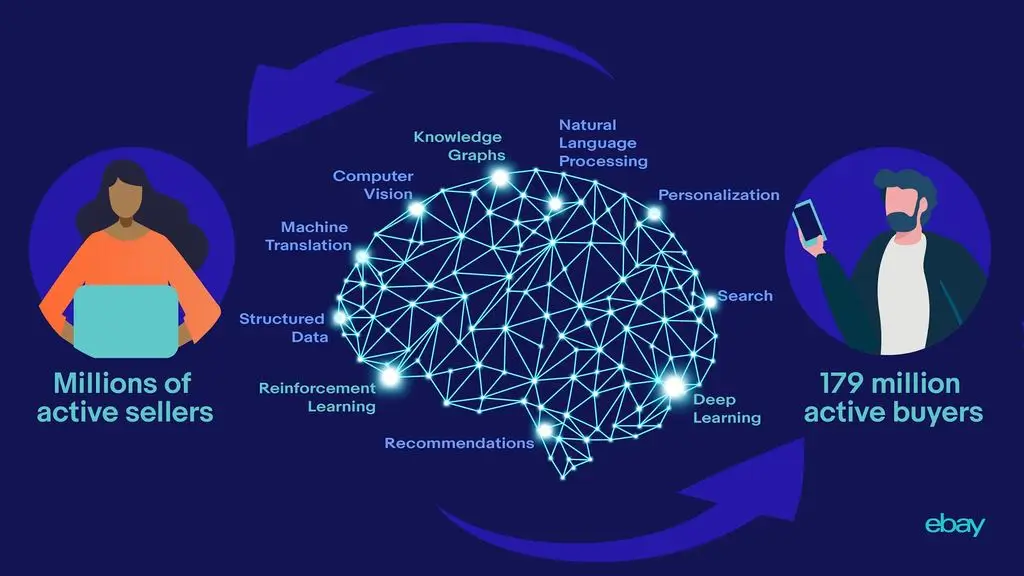
eBay’s AI also focuses on account takeover fraud, where hackers gain access to legitimate user accounts and exploit them for fraudulent purchases. By analyzing login behavior, device usage, and purchase history, the AI can detect when an account behaves abnormally compared to its historical patterns. These AI in eCommerce examples highlight how anomaly detection protects both buyers and sellers by stopping fraud before it causes significant damage.
Like Alibaba, eBay’s models improve continuously. Feedback loops from confirmed fraud cases train the AI to refine its detection thresholds, ensuring it becomes more accurate over time. These AI in eCommerce examples illustrate how machine learning creates systems that adapt to evolving fraud tactics, offering protection that grows stronger with experience.
Result: Massive fraud reduction in peak sales
The greatest advantage of these AI in eCommerce examples lies in their ability to reduce fraud dramatically during peak sales periods, when traditional systems often fail. Events like Singles’ Day, Black Friday, and Cyber Monday create ideal conditions for fraudsters, as the sheer volume of transactions makes anomalies harder to detect manually. Real-time anomaly detection ensures that fraudulent behavior is identified immediately, preventing criminals from exploiting high-traffic windows.
For merchants, this translates into fewer chargebacks, reduced losses, and lower operational costs. Fraudulent transactions are stopped before they can be processed, sparing businesses from both direct financial damage and the administrative burden of resolving disputes. These AI in eCommerce examples demonstrate that anomaly detection not only saves money but also preserves resources that can be reinvested in growth and innovation.

For customers, real-time anomaly detection creates a secure shopping environment. Shoppers can participate in massive sales events with confidence, knowing their transactions are protected even amid billions of purchases. Reduced fraud also means fewer cases of account compromise, stolen payment information, or delivery of counterfeit goods. These AI in eCommerce examples show that security is not just a technical feature but a driver of customer trust and long-term loyalty.
The impact extends beyond individual companies. On a macro scale, the success of AI-driven anomaly detection during major sales events strengthens confidence in global digital commerce. Retailers can run high-profile promotions without fear of being overwhelmed by fraud, while consumers embrace these events with enthusiasm. These AI in eCommerce examples underline the critical role of artificial intelligence in supporting the growth and sustainability of eCommerce worldwide.
AI in Sustainability & Ethical eCommerce
Sustainability and ethics have become central themes in modern retail, with consumers increasingly demanding that businesses not only deliver quality products but also operate responsibly. Climate change, overproduction, waste, and exploitative supply chains have all raised questions about the long-term viability of eCommerce if it continues on a purely growth-driven trajectory. Today’s shoppers—particularly Millennials and Gen Z—prioritize brands that demonstrate environmental responsibility, ethical sourcing, and transparency. Among the most forward-looking AI in eCommerce examples are those that leverage artificial intelligence to create greener supply chains, reduce waste, promote ethical practices, and empower customers to shop more responsibly.

The challenge is complex. Traditional eCommerce models often encourage overproduction to meet fluctuating demand, generate excessive packaging waste, and rely on opaque global supply chains that may hide unethical practices. Without advanced technology, balancing profitability with sustainability has seemed nearly impossible. This is where AI provides a transformative advantage. By applying predictive analytics, natural language processing, and machine learning, companies can optimize production, monitor supply chains, reduce waste, and align more closely with consumer expectations for ethical behavior. These AI in eCommerce examples show how artificial intelligence not only drives efficiency but also embeds sustainability into the DNA of modern retail.
Reducing waste with AI forecasts
One of the most pressing challenges in global commerce is the enormous amount of waste generated through overproduction, mismanaged supply chains, and unsold inventory. In industries like fashion, food, and consumer goods, millions of tons of products are either discarded or destroyed every year because businesses fail to align production with true consumer demand. Not only does this result in financial losses, but it also has devastating environmental consequences. Among the most impactful AI in eCommerce examples are those where artificial intelligence is used to reduce waste by making forecasts smarter, more precise, and more adaptive.

AI forecasting allows retailers and manufacturers to anticipate demand accurately by analyzing a wide variety of signals—historical sales, social media trends, regional preferences, macroeconomic data, and even weather patterns. Instead of relying on human intuition or outdated models, companies can now leverage machine learning systems that continuously refine predictions based on real-time inputs. These AI in eCommerce examples show that sustainability and profitability can go hand in hand when businesses align supply with demand intelligently. By producing only what customers are likely to purchase, companies not only save money but also reduce waste, cut emissions, and build stronger reputations as sustainable retailers.
H&M AI predicting stock needs
One of the most widely recognized AI in eCommerce examples of reducing waste comes from H&M, the global fashion retailer. With thousands of stores and a massive eCommerce operation, H&M faces the constant challenge of predicting what styles, colors, and sizes will resonate with shoppers in different markets. Historically, misjudgments in this process led to overproduction, unsold stock, and the eventual disposal or heavy discounting of items.
To address this, H&M turned to AI-driven forecasting. The company developed algorithms that analyze billions of data points, including historical sales records, customer browsing behavior, and regional buying patterns. AI models also incorporate external factors such as seasonality, local holidays, and even weather forecasts to anticipate demand more accurately. For example, if unseasonably warm weather is predicted in northern Europe, H&M’s AI system reduces orders for winter coats while increasing stock for lighter apparel.
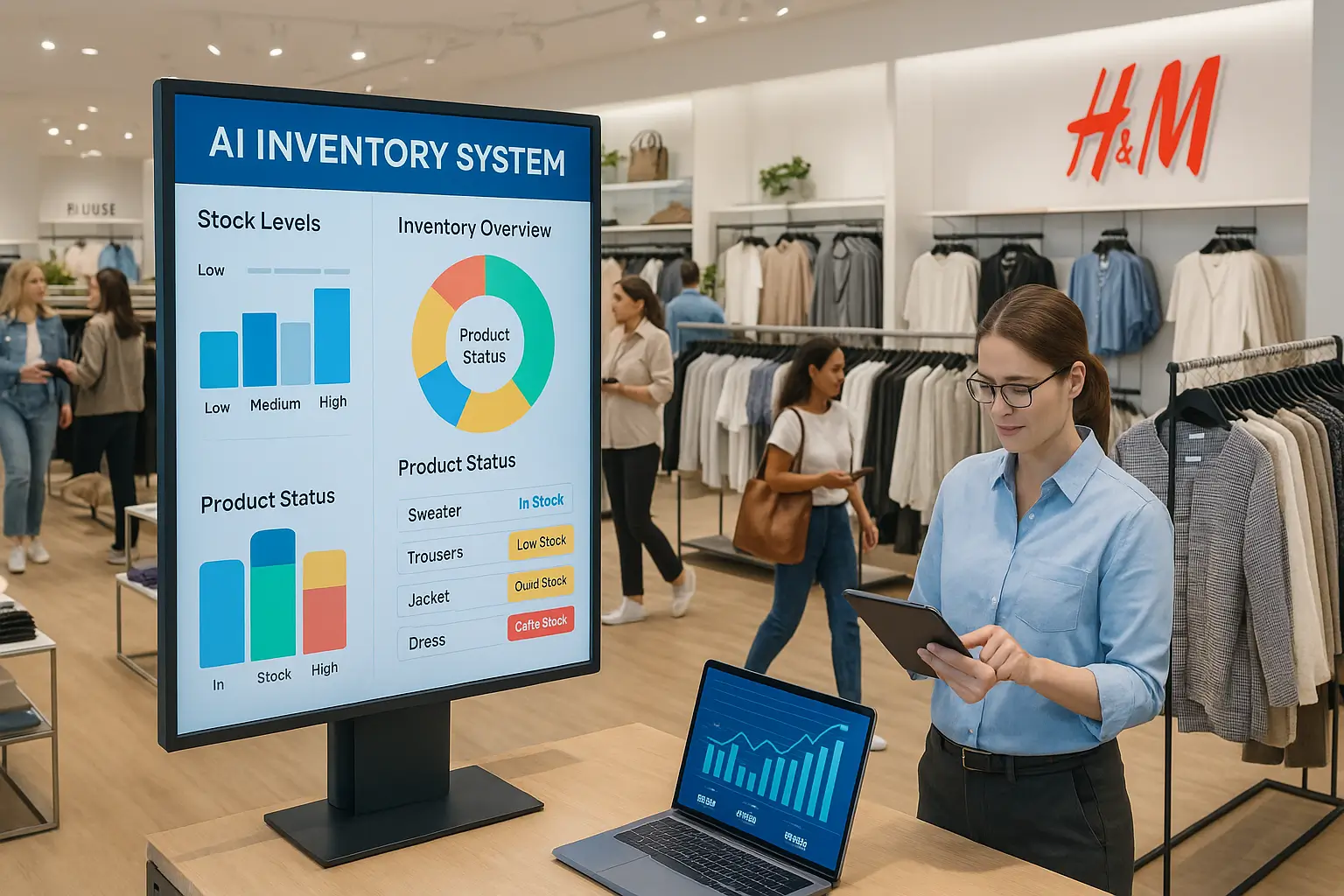
These AI in eCommerce examples highlight how artificial intelligence replaces guesswork with precision. Instead of producing generic amounts of each product across global markets, H&M can tailor inventory to local demand. This reduces waste from overproduction and minimizes markdowns, while also ensuring that customers find the items they want in stock.
The impact extends beyond efficiency. By aligning production with demand, H&M reduces its environmental footprint, contributing to its broader sustainability goals. These AI in eCommerce examples demonstrate how AI forecasts not only improve profitability but also address the industry’s responsibility to reduce textile waste and overconsumption.
Unilever optimizing supply to cut waste
Another powerful case among AI in eCommerce examples is Unilever, one of the world’s largest consumer goods companies. With a product portfolio spanning food, personal care, and household items, Unilever must manage highly complex global supply chains. Misalignment between supply and demand in this context can lead to food spoilage, wasted raw materials, and significant environmental costs.
Unilever has adopted AI-powered forecasting systems to optimize supply chain operations and minimize waste. By using machine learning models, the company analyzes sales data, market signals, and production cycles in real time. For instance, AI can predict demand surges for ice cream during heatwaves or anticipate increased sales of cleaning products during flu season. These forecasts allow Unilever to adjust production schedules and distribution plans proactively, reducing waste while ensuring shelves remain stocked.

These AI in eCommerce examples illustrate how predictive intelligence directly supports sustainability goals. In food and beverage segments, AI reduces the risk of overproduction, which often results in products expiring before they reach customers. In personal care and household goods, AI ensures the right volumes are produced and distributed to the right markets, minimizing unnecessary transport and storage costs.
The business benefits are equally significant. By cutting waste, Unilever lowers raw material costs, reduces energy consumption in manufacturing, and improves profitability. These AI in eCommerce examples prove that sustainable practices do not come at the expense of profit—in fact, they often enhance it by eliminating inefficiencies across the supply chain.
Effect: sustainability + profitability
The combined effect of these AI in eCommerce examples from H&M and Unilever is clear: smarter forecasts deliver both sustainability and profitability. Traditionally, these two goals were seen as competing priorities. Businesses believed they had to choose between maximizing profits and reducing their environmental impact. Artificial intelligence has overturned this assumption by proving that waste reduction strategies can also drive financial performance.
From a sustainability perspective, AI forecasting reduces overproduction, cutting down on the raw materials, water, and energy required to manufacture goods that may never be sold. This also lowers greenhouse gas emissions associated with production and distribution. These AI in eCommerce examples show how businesses can significantly reduce their carbon footprints while aligning with consumer demand for eco-friendly practices.

From a profitability perspective, fewer wasted products mean fewer markdowns, lower storage costs, and reduced write-offs for unsold inventory. Companies also avoid reputational risks associated with wasteful practices, such as destroying unsold stock, which has drawn criticism in industries like fashion. These AI in eCommerce examples demonstrate that businesses can safeguard their bottom line while building stronger brand loyalty among environmentally conscious consumers.
Customer satisfaction also improves. Shoppers are less likely to encounter stockouts when AI ensures the right products are available at the right time. At the same time, they gain confidence in brands that actively pursue sustainability, deepening loyalty and encouraging repeat purchases. These AI in eCommerce examples highlight how forecasts powered by artificial intelligence create a virtuous cycle: reduced waste leads to higher efficiency, stronger trust, and long-term profitability.
Strategically, the role of AI in reducing waste extends beyond individual companies. Industry-wide adoption of AI forecasting could significantly reduce the environmental impact of global retail, contributing to larger sustainability goals such as the United Nations’ Sustainable Development Goals (SDGs). These AI in eCommerce examples prove that artificial intelligence is not just a tool for competitive advantage but also a force for systemic change in how commerce operates.
AI-driven circular economy
The traditional linear model of commerce—produce, sell, use, and discard—has long dominated global retail. While profitable in the short term, this approach creates enormous waste and environmental damage. In fashion, for example, millions of tons of clothing are sent to landfills or incinerated each year. In consumer goods, products often have short lifecycles that encourage overconsumption. To combat this, businesses and consumers alike are embracing the concept of the circular economy, where products are reused, repaired, resold, or recycled to extend their lifespans. Among the most innovative AI in eCommerce examples are those that leverage artificial intelligence to power circular economy models, enabling sustainable practices while maintaining profitability.

AI-driven circular economy initiatives use machine learning, predictive analytics, and computer vision to make resale, re-commerce, and recycling processes more efficient. AI helps evaluate the condition of secondhand items, match them with the right buyers, and manage logistics at scale. These AI in eCommerce examples prove that artificial intelligence is not just a tool for efficiency but a critical enabler of new, sustainable business models that align with consumer values and global environmental goals.
ThredUp AI resale and re-commerce platform
One of the clearest AI in eCommerce examples of circular economy practices comes from ThredUp, one of the largest online resale and consignment platforms for secondhand clothing. ThredUp’s mission is to extend the lifecycle of garments by making it easy for consumers to buy and sell secondhand fashion. However, operating such a large-scale resale marketplace poses challenges: every item is unique, condition varies, and processing thousands of garments daily requires enormous efficiency. This is where AI plays a critical role.
ThredUp uses AI to automate the intake, sorting, and pricing of secondhand items. Machine learning algorithms analyze product details, such as brand, style, material, and visible condition, to determine resale value. Computer vision systems inspect garments for wear and tear, stains, or authenticity markers, allowing the platform to process items much faster than human workers could. These AI in eCommerce examples highlight how artificial intelligence scales the complex logistics of re-commerce, making resale viable at a commercial level.

AI also powers personalization on ThredUp’s platform. By analyzing shopper behavior and preferences, AI recommends secondhand items that match each user’s style and size. This makes the experience of buying secondhand as convenient as shopping for new items, addressing one of the barriers to adoption. These AI in eCommerce examples illustrate how re-commerce can be positioned not as a compromise but as a desirable, mainstream shopping choice.
The sustainability outcomes are significant. By giving garments a second life, ThredUp reduces textile waste and lowers demand for new production, which in turn cuts water usage, chemical pollution, and carbon emissions. At the same time, profitability is maintained through efficient operations and strong customer engagement. These AI in eCommerce examples demonstrate that AI-powered re-commerce can be both sustainable and scalable.
Patagonia Worn Wear AI sorting secondhand items
Another powerful case among AI in eCommerce examples is Patagonia’s Worn Wear initiative, which focuses on extending product lifecycles through repair, resale, and recycling. Patagonia has long been a leader in sustainable practices, and Worn Wear is its flagship program to encourage customers to return used products for refurbishment and resale. The challenge lies in handling thousands of unique items returned in varying conditions. Artificial intelligence helps solve this.
Patagonia employs AI systems that assist in sorting and categorizing returned items. Computer vision inspects garments to assess wear levels, detect damage, and identify whether products are suitable for resale, repair, or recycling. Machine learning models then guide decision-making: some items are cleaned and resold as “like new,” others are refurbished with minor repairs, and items beyond repair are sent for recycling into new textiles. These AI in eCommerce examples show how artificial intelligence enables circular economy operations at scale, making it efficient to process large volumes of returns.
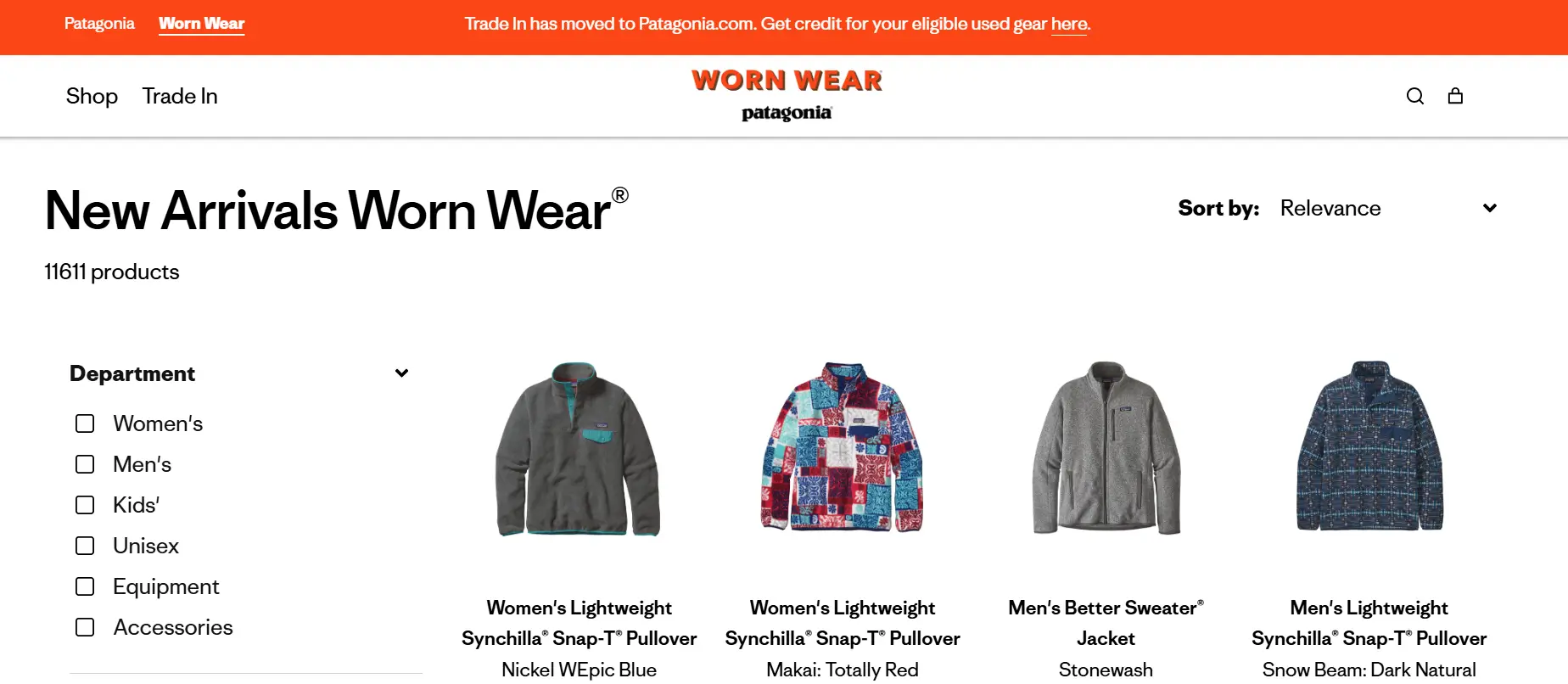
AI also helps Patagonia optimize resale pricing. By analyzing demand patterns, seasonal factors, and product desirability, algorithms assign dynamic price points to maximize resale value while ensuring affordability. This not only extends the product lifecycle but also reinforces Patagonia’s mission to promote sustainable consumption. These AI in eCommerce examples illustrate how technology integrates environmental responsibility with sound business strategy.
For customers, AI-driven Worn Wear creates a transparent and trustworthy re-commerce experience. Shoppers can confidently buy secondhand items knowing they have been carefully evaluated and priced fairly by AI systems. These AI in eCommerce examples highlight how artificial intelligence builds trust and credibility in the resale market, encouraging more customers to participate.
Result: Extending product lifecycles
The ultimate impact of these AI in eCommerce examples from ThredUp and Patagonia is the extension of product lifecycles, which lies at the heart of the circular economy. By keeping products in use longer, companies reduce demand for virgin resources, cut waste, and lower the environmental footprint of retail. At the same time, they open new revenue streams and strengthen customer relationships.
From a sustainability perspective, extending product lifecycles reduces greenhouse gas emissions, water consumption, and landfill waste. Fashion, in particular, benefits from AI-driven re-commerce, as the industry is one of the largest global polluters. These AI in eCommerce examples prove that circular economy practices are not only desirable but necessary to address the environmental challenges facing retail.

From a profitability perspective, re-commerce and resale create value from items that would otherwise generate no revenue. Retailers and platforms can monetize secondhand goods while building stronger connections with environmentally conscious consumers. These AI in eCommerce examples show that sustainability does not mean sacrificing profit—it means creating smarter, more resilient business models.
Another major benefit is customer engagement. Consumers increasingly want to align their shopping habits with their values. When companies offer AI-driven re-commerce platforms, they empower customers to participate in sustainability without sacrificing convenience or style. These AI in eCommerce examples highlight how extending product lifecycles builds loyalty, trust, and advocacy.
Strategically, AI-driven circular economy initiatives also future-proof businesses. As regulations around sustainability tighten and consumer demand for ethical practices grows, companies with established re-commerce systems will have a competitive edge. These AI in eCommerce examples demonstrate how forward-looking retailers can position themselves as leaders in both innovation and responsibility.
Carbon footprint tracking
One of the biggest criticisms of eCommerce is its environmental impact. While online shopping offers convenience and efficiency, it also generates significant carbon emissions through manufacturing, packaging, warehousing, and delivery. The explosion of same-day and next-day delivery has only increased the strain, as retailers rush to move products quickly, often at the expense of sustainability. Consumers, governments, and investors are now pressuring businesses to take responsibility for their environmental impact. Among the most innovative AI in eCommerce examples is carbon footprint tracking, where artificial intelligence helps retailers measure, analyze, and offset emissions across their supply chains and customer transactions.

Carbon tracking has historically been challenging because of the complexity of global commerce. Every product’s carbon footprint is influenced by raw materials, production processes, transportation modes, energy consumption, and last-mile delivery. Traditional methods of calculating emissions relied on broad averages, which were often inaccurate and failed to provide actionable insights. Artificial intelligence changes this by analyzing vast datasets in real time, identifying emissions at a granular level, and recommending strategies for reduction. These AI in eCommerce examples show how technology allows companies not only to track their environmental impact but also to align business practices with broader green goals.
Shopify AI tools for carbon-neutral checkout
One of the most prominent AI in eCommerce examples in carbon footprint tracking comes from Shopify, which has integrated sustainability features into its platform. Shopify offers tools that allow merchants to provide customers with carbon-neutral checkout options, powered by AI and machine learning.
The system analyzes each transaction to estimate the carbon emissions generated by producing, packaging, and shipping the purchased product. Factors such as shipping distance, delivery speed, and carrier efficiency are considered, creating a detailed emissions profile for every order. Once calculated, the system automatically suggests offsets through investments in carbon removal or reforestation projects. These AI in eCommerce examples highlight how artificial intelligence brings transparency and accountability to the customer experience.

For shoppers, the benefit is clear: they can make purchasing decisions that align with their environmental values. Instead of feeling guilty about the impact of fast shipping, customers can see the carbon cost of their choices and opt to neutralize it instantly. These AI in eCommerce examples show how retailers can empower consumers to participate directly in sustainability efforts, fostering loyalty and brand trust.
For merchants, Shopify’s AI-driven carbon tracking offers a competitive advantage. Businesses can market themselves as eco-conscious while differentiating their offerings in crowded markets. More importantly, AI helps merchants understand their own emissions data, giving them insights to optimize logistics, reduce packaging waste, and negotiate with greener suppliers. These AI in eCommerce examples demonstrate how carbon-neutral checkout is not just a marketing feature but a data-driven strategy for sustainability.
Microsoft cloud-based emissions tracking for retailers
Another important case among AI in eCommerce examples comes from Microsoft, which has developed cloud-based solutions for emissions tracking that support retailers worldwide. Through its Microsoft Cloud for Sustainability platform, the company provides AI-powered tools that collect, standardize, and analyze emissions data across entire supply chains.
Retailers often operate globally, sourcing raw materials from one region, manufacturing in another, and distributing to customers across continents. Tracking the carbon footprint of such complex operations is nearly impossible without advanced technology. Microsoft’s AI models aggregate data from energy usage, logistics partners, production facilities, and distribution centers, creating a holistic view of emissions. These AI in eCommerce examples illustrate how artificial intelligence provides clarity in a domain historically marked by opacity.
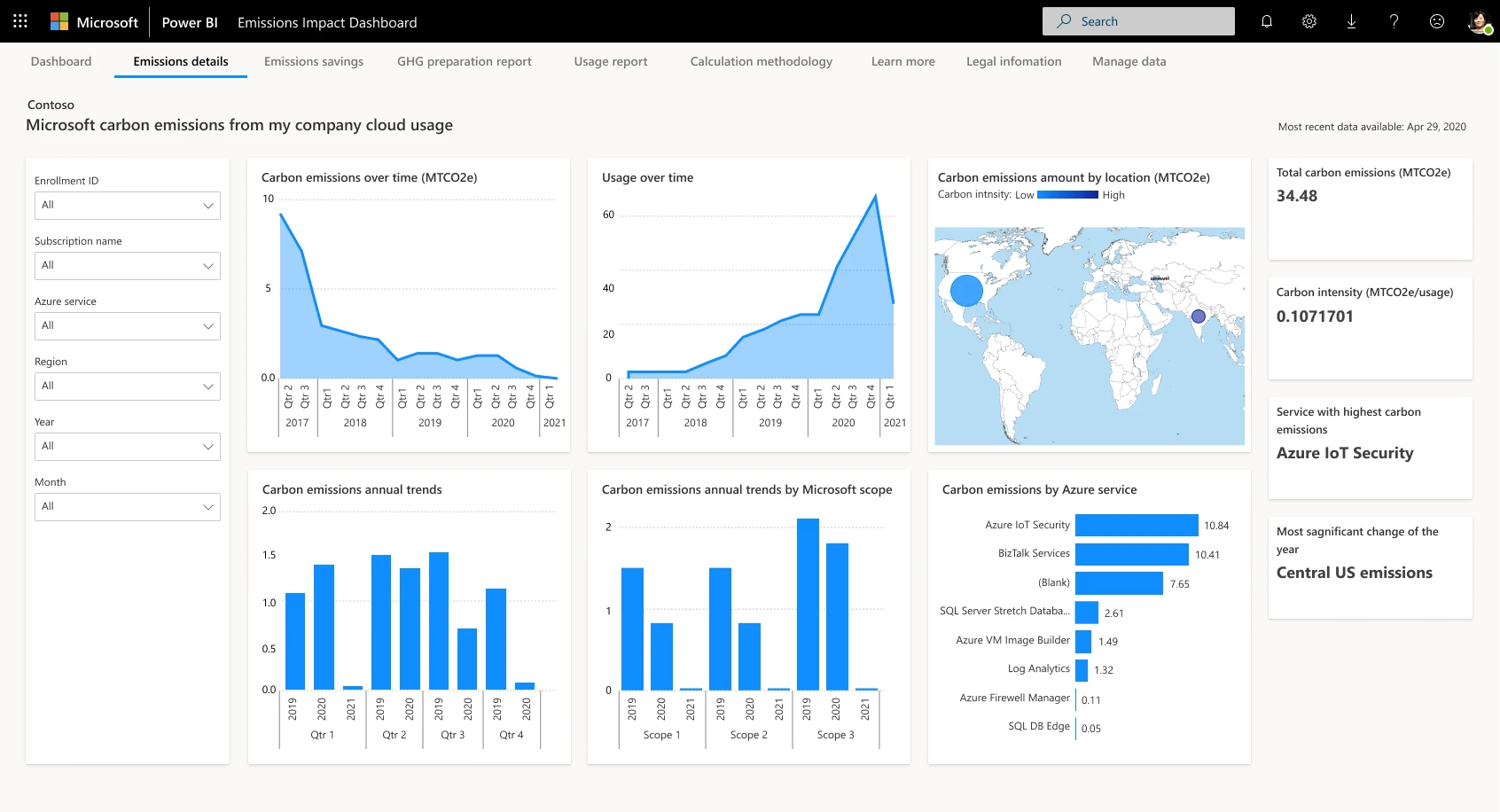
The platform does more than calculate—it recommends. AI algorithms identify hotspots where emissions are highest and suggest interventions, such as switching to renewable energy, optimizing shipping routes, or consolidating warehouses. Retailers can also run predictive scenarios, estimating the carbon impact of different supply chain strategies before implementing them. These AI in eCommerce examples show how artificial intelligence transforms carbon tracking from a reactive reporting exercise into a proactive sustainability strategy.
Microsoft’s tools also support regulatory compliance. As governments worldwide introduce stricter reporting requirements on emissions, retailers must provide accurate, auditable data. AI ensures that emissions reports are both precise and transparent, reducing the risk of penalties while improving corporate accountability. These AI in eCommerce examples highlight how emissions tracking is not just about customer-facing features but also about long-term regulatory and investor confidence.
Result: Aligning eCommerce with green goals
The broader outcome of these AI in eCommerce examples is the alignment of online retail with global green goals. As climate change becomes a defining issue of our time, businesses that fail to address their carbon impact risk losing both consumer trust and market relevance. Artificial intelligence provides the tools to make carbon tracking practical, scalable, and effective, ensuring that sustainability becomes an integral part of eCommerce operations.
From a business perspective, the benefits are twofold. First, AI-driven carbon tracking reduces operational inefficiencies. By analyzing supply chains, companies can identify opportunities to cut costs while lowering emissions, such as optimizing delivery routes or consolidating shipments. Second, it creates a strong value proposition for consumers, who increasingly prioritize sustainability in their purchasing decisions. These AI in eCommerce examples demonstrate how aligning with green goals can strengthen brand loyalty, attract environmentally conscious shoppers, and differentiate companies in competitive markets.

From an environmental perspective, the impact is profound. By tracking and reducing carbon emissions, eCommerce companies contribute directly to climate mitigation. Whether through more efficient logistics, renewable energy adoption, or investment in carbon offset projects, AI-driven strategies reduce the footprint of digital commerce. These AI in eCommerce examples prove that retail can play a leading role in achieving sustainability targets such as the Paris Agreement goals or the United Nations Sustainable Development Goals (SDGs).
Moreover, AI creates transparency. Consumers are no longer satisfied with vague sustainability claims—they demand proof. By presenting carbon data at checkout, or by publishing detailed emissions reports, companies can demonstrate genuine accountability. These AI in eCommerce examples highlight how artificial intelligence fosters trust by turning sustainability from a buzzword into measurable action.
Conclusion
AI at the operational level is about more than efficiency; it’s about building resilient and trustworthy commerce. From adaptive pricing and predictive warehouses to fraud prevention and sustainability tracking, businesses are rewriting how value chains function. These examples highlight that intelligence behind the scenes is as crucial as the AI customers see upfront. Without these systems, even the most engaging customer-facing features would quickly collapse under inefficiencies, delays, or risks.
At the same time, this cannot be separated from the innovations in Part 1. Personalized recommendations, conversational AI, and immersive shopping experiences all depend on stable, AI-powered back-end systems that ensure products are available, payments are secure, and operations are transparent. In this sense, AI in eCommerce examples reveal a single, interconnected ecosystem where the front-end delights and back-end foundations reinforce each other.
Together, the two halves show that AI is both the face and the engine of commerce. For businesses, the message is clear: success in the digital economy requires a holistic embrace of AI, not as an add-on but as a core strategy. Those who invest in intelligence across the entire value chain—customer engagement and operational infrastructure alike—will be best positioned to thrive in a marketplace where speed, personalization, trust, and sustainability define long-term competitiveness and growth.



